
ACT
INFORMATION
RELEASED UNDER THE OFFICIAL
link to page 3 link to page 4 link to page 4 link to page 5 link to page 6 link to page 7 link to page 8
Contents
BACKGROUND
2
GOVERNMENT SURVEY
3
Why do you think dogs attack?
3 ACT
What do you think is the best way to reduce dog attacks?
4
What can owners do?
5
What can local councils do?
6
What can central government do?
7
HOW NZKC CAN ASSIST
8
INFORMATION
E OFFICIAL
RELEASED
RELEASED UNDER THE OFFICIAL
1
BACKGROUND
The New Zealand Kennel Club (NZKC) is the largest organisation of dog owners in New
Zealand. Currently it is a ‘club of clubs’ and a ‘club of individuals’ with about 5,700
individual members spread across 287 clubs throughout New Zealand. NZKC was formed in
1886 and is an incorporated society.
NZKC is very much based on the celebration of the benefits of the dog/human relationship
for individuals of all ages and recognise that dogs are part of our community and working ACT
dogs are an essential part of our success as an agricultural country.
NZKC is the umbrella organisation for three main disciplines:
Conformation ( 65% of membership)
Agility (21 %)
Obedience (14%)
All three disciplines are involved in their own range of sports and competitions which are
INFORMATION
the cornerstone of NZKC’s existence.
In addition our conformation membership is very heavily involved in the breeding and sale
of (pedigree) pure bred dogs. The NZKC maintains a registry for 218 recognised breeds of
dog where qualification requirements must be met e.g. a three generation pedigree for the
dog must be available and the NZKC member must have been granted a NZKC kennel name
i.e. a licence to breed and register progeny.
E OFFICIAL
The other area the NZKC membership is heavily involved in is the provision of domestic dog
training/owner education throughout New Zealand. This service is provided by
approximately 300 volunteers from 46 Obedience clubs. Approximately 12,000
puppies/dogs are trained per annum under the umbrella of the internationally acclaimed
Canine Good Citizen programme which the NZKC administers in this country.
RELEASED
RELEASED UNDER THE OFFICIAL
2
GOVERNMENT SURVEY
Why do you think dogs attack?
Any dog has the capacity to attack with the potential to damage heightened in a pack
situation.
Dogs attack as a reaction to a stressful situation. They may attack because they’re scared
or threatened. They may attack to protect themselves, their puppies, their food, their
ACT
property or their owners. They may attack if they’re not feeling well, in pain or if they’re
startled, and they may also nip or bite during play (which is why rough play should be
avoided to ensure that the dog is not overly excited).
NZKC agrees with the body of international research and experience that breed specific
legislation does not work. Dog aggression is more complex than simply genetics. However,
there are breeds that owners and the public need to be mindful of as some have the
potential to do more damage than others when they do attack or bite. This does become a
double edged sword as a fear of dogs can fuel aggression by the animal. This fear can be
INFORMATION
stimulated by media focus and attention particularly when certain breeds or types are
identified.
The NZKC believes that the biggest contributing factor to dog attacks is a lack of education
1) of owners 2) of the dogs themselves (lack of training) and 3) of the non-dog owning
public and children in particular.
An animal is part product of its environment. We fully understand that this is a very
E OFFICIAL
complex issue. There is a segment of the population who already do not comply with
central and local government requirements e.g. not to register their dogs and they are
then less likely to be involved in what we see as being of the greatest benefit i.e. an
increase in dog training and owner education. Experience tells us that this same segment
are more likely to be attracted to dogs with that potential to do more damage when they
bite.
RELEASED
RELEASED UNDER THE OFFICIAL
3
What do you think is the best way to reduce dog attacks?
NZKC believes the best way to reduce dog attacks is through education. We are New
Zealand’s largest service provider in this area. As reported in this document the NZKC has
46 member clubs spread throughout New Zealand delivering dog training classes and
owner education under the banner of the internationally acclaimed Canine Good Citizen
programme. This training and education is open to all i.e. not restricted to NZKC
members.
ACT
NZKC believes all dog owners should attend dog training classes and, as much as possible,
involve all family members associated with the dog. As a minimum requirement NZKC
believes that dog training and owner education should be mandatory for the registered
owner of the dog. We also believe that dog training as such needs to be defined i.e. it is
more than attendance at puppy classes. An analogy can be drawn with child education. It
does not stop after kindergarten.
NZKC questions the process involved in the re-homing of unwanted dogs. Is the process
INFORMATION
rigorous enough in ensuring that these dogs are suitable for re-homing when many have
had extremely unfortunate circumstances to contend with and consequently, through no
fault of their own, have the potential to attack and damage?
The first step in a model going forward must be to identify all parties currently involved in
any legislative, educational and management capacity regarding dogs and dog
OFFICIAL
ownership. In simple terms this would be a stocktake of interested parties to establish the
starting point for strategies and plans to be developed and resources targeted to ensure
both dog owners and non-owners alike will feel safer within their environments.
The NZKC is becoming increasingly aware of the number of individuals and/or groups
becoming involved in dog safety education programmes, in schools in particular, however,
there does not appear to be any protocols in place to ensure that the programmes being
delivered are best practice models.
RELEASED UNDER THE
RELEASED UNDER THE OFFICIAL
4
What can owners do?
Generally the problems appear to lie with those individuals who own unregistered dogs.
The first step must be to target and upskill these owners.
Dog attacks will be reduced to some extent by dogs being kept on a leash. However, one
key reason that dogs are not kept on a leash is that owners have trouble controlling them
when the dog is restrained in this manner and this once again reinforces the need for
education and training.
ACT
There is also very sound reasoning to have dangerous and menacing dogs classified as
requiring muzzles when in public. NZKC supports the legislation already in place and any
common sense approach to an extension of it. We do not support breed specific
legislation.
All properties with dogs should be fenced. All citizens have a right to walk with or without
a dog on our streets without the fear of a dog rushing out at them
NZKC is of the belief that a fit and active dog is a much better companion animal and
INFORMATION
member of society. Consequently, NZKC is also heavily involved in a wide range of
competitions and sports which cater for both pure bred and cross bred dogs. We believe
owners should be encouraged to become involved in any club or organisation offering
services based on dog socialisation and activities.
E OFFICIAL
RELEASED
RELEASED UNDER THE OFFICIAL
5
What can local councils do?
NZKC sees local councils as having a responsibility to keep their citizens safe and that this
responsibility extends to safety from irresponsible dog owners and their dogs. We believe
that the local council’s funding policies should clearly distinguish between the services
provided for compliant dog owners and those who are non-compliant. A likely outcome of
the drive to make dog owners and the general public safer will be increased costs and the
NZKC and its membership do not wish to share in this cost any more than other
responsible dog owners and the general public.
ACT
We believe that a first step for local councils is a concerted drive to target the owners of
unregistered dogs. NZKC is aware of and applauds Auckland City Council’s recent
initiative. We are very interested in the outcomes in terms of the affected dogs and the
part that education and training has to play in these situations. We are also interested in
what resource is required for such targeting of non-compliant owners and any subsequent
education and training.
NZKC believes that the services provided by the Animal Management groups within local
government bodies are extremely valuable and to the best of our knowledge executed
INFORMATION
very well. We believe this needs to be further resourced, particularly in the short to
medium term, targeting dangerous dogs which are more likely to be unregistered.
We reinforce our desire to see greater co-ordination in relation to dog education and
training as it applies to local councils and their Animal Management teams. NZKC sees a
role for local councils in the monitoring and auditing of dog training and owner education
particularly if it is to become mandatory as recommended.
E OFFICIAL
NZKC believes the costs associated with services provided as a result of non-compliant
owners should not fall solely on compliant dog owners i.e. they should be borne evenly by
all ratepayers.
RELEASED
RELEASED UNDER THE OFFICIAL
6
What can central government do?
NZKC believes central government must take a greater role in raising public awareness
about safety around dogs and take a co-ordination role of those involved in dog education
and dog ownership and the benefits of it for dog owners and the general public. The latter
may be a short to medium term position for central government and the Department of
Internal Affairs in particular. There certainly appears to be a disjointed approach to dog
education in New Zealand and NZKC sees itself is part of that disjointedness. We recognise
the work we are doing in this area is not well known but this is work in progress with
ACT
initiatives set out in this document. (Refer last section in particular).
In recent years, a strong correlation between domestic violence, animal abuse and the
incidence of aggressive dog behaviour has been established. Child and animal protection
professionals have recognised this link. Anecdotal evidence from within NZKC and those
involved in dog training also supports this link e.g. dogs chained unnecessarily and/or not
exercised etc. and aggressive behaviour. Animal cruelty is one of the earliest and most
dramatic indicators that an individual is developing a pattern of seeking power and
control through abuse of others. When animals in a home are abused or neglected, it is a
warning sign that others in the household may be in danger. When looking at this from a
INFORMATION
dog attack perspective why would any household, where family violence has been
identified, be allowed to own dogs?
NZKC would like to see more police intervention and support of local government Animal
Management services to ensure that non-compliant owners have their dogs impounded
and any household with domestic violence issues is are treated similarly.
E OFFICIAL
RELEASED
RELEASED UNDER THE OFFICIAL
7
HOW NZKC CAN ASSIST
NZKC has for some time been considering the challenges and opportunities involved with
the expansion of our services in the dog owner education/dog obedience areas. In recent
times the subject of Dangerous Dogs was a topic of discussion at NZKC’s June 25, 2016
Annual Conference. A panel of outside parties was involved including representatives
from NZVA, SPCA and Wellington City Council. A summary of the discussion and NZKC’s
previous considerations and ensuing, possible solutions is provided below.
ACT
It was clearly felt that a great deal of work and outside support would be required for
NZKC, our member clubs and volunteers to extend our services to encompass reactive,
difficult and dangerous dogs.
Furthermore, as the current services provided are nearly all undertaken by volunteer
personnel any extension of these services to encompass more dogs (and their owners)
would similarly require a great deal of work and outside support.
These challenges are well understood and the organisation has discussed a range of
solutions, including:
INFORMATION
•
NZKC business model prepared to include self-funding opportunities
•
Meeting organised with interested groups – NZKC/DIA/LGNZ/ACC/SPCA/NZVA
etc.
•
Conference held in mid-2017 bringing together personnel from NZKC’s 46 member
clubs to establish a best practice model
•
Discussions continue with tertiary institutions in establishing a tiered course for
E OFFICIAL
dog trainers
•
Regional seminar training programme be established (training the trainers)
•
Relationships developed between NZKC member clubs and private trainers
•
NZKC organises an open to all, annual dog trainers conference
•
NZKC introduces pilot schemes to bring together interested parties – 2016
NZKC/Central All Breeds Dog Training Club/Wellington City Council/2017 similar in
Porirua.
NZKC currently has no set view on either owner licencing and/or breeder licencing. We are
already involved in both and more particularly the latter. Nearly 50% of NZKC’s members
(2,867) have active kennel names i.e. a licence to breed and register the progeny. These
members are bound by NZKC Rules, Regulations and a Breeders Code of Ethics. There are
also standards in place for the granting of a new kennel name. Nearly 8,000 puppies are
RELEASED
RELEASED UNDER THE OFFICIAL
registered annually of which approximately 60% are sold to the public. Therefore, the
NZKC and its breeders have responsibilities to raise puppies that are well socialised and an
opportunity to educate new owners as to their responsibilities.
8
ACT
INFORMATION
E OFFICIAL
RELEASED
RELEASED UNDER THE OFFICIAL
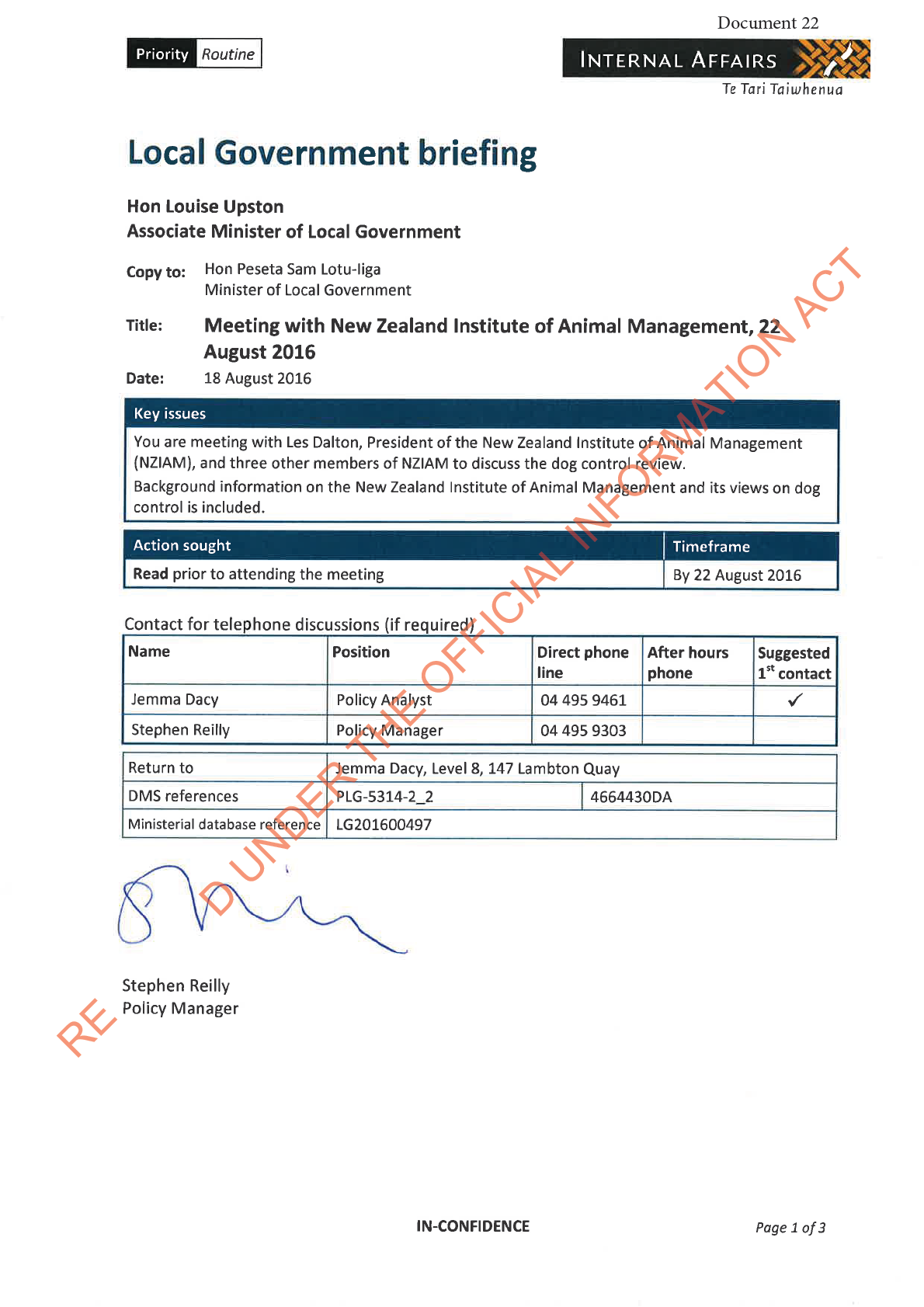
ACT
INFORMATION
RELEASED UNDER THE OFFICIAL
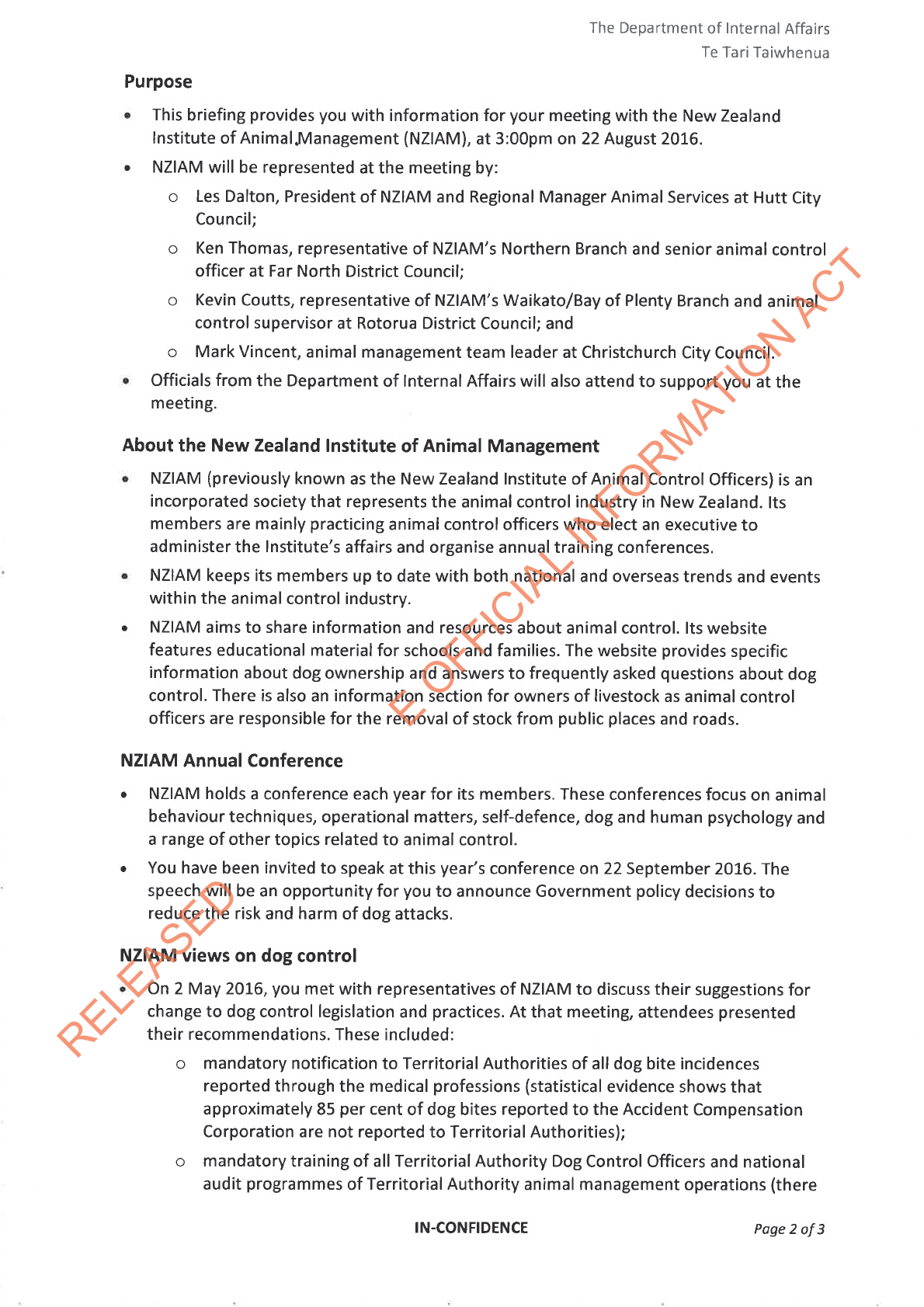
ACT
INFORMATION
RELEASED UNDER THE OFFICIAL
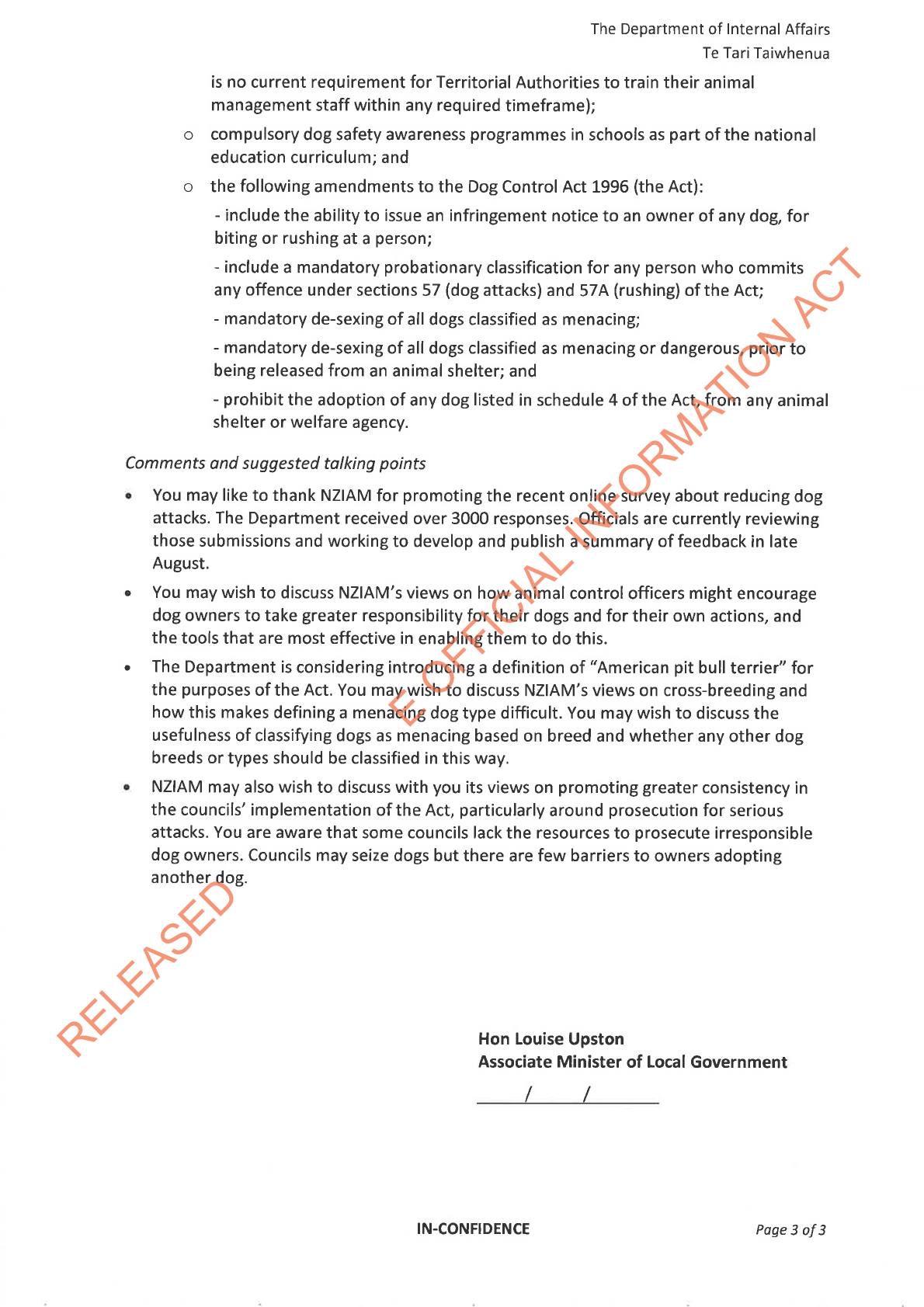
ACT
INFORMATION
RELEASED UNDER THE OFFICIAL
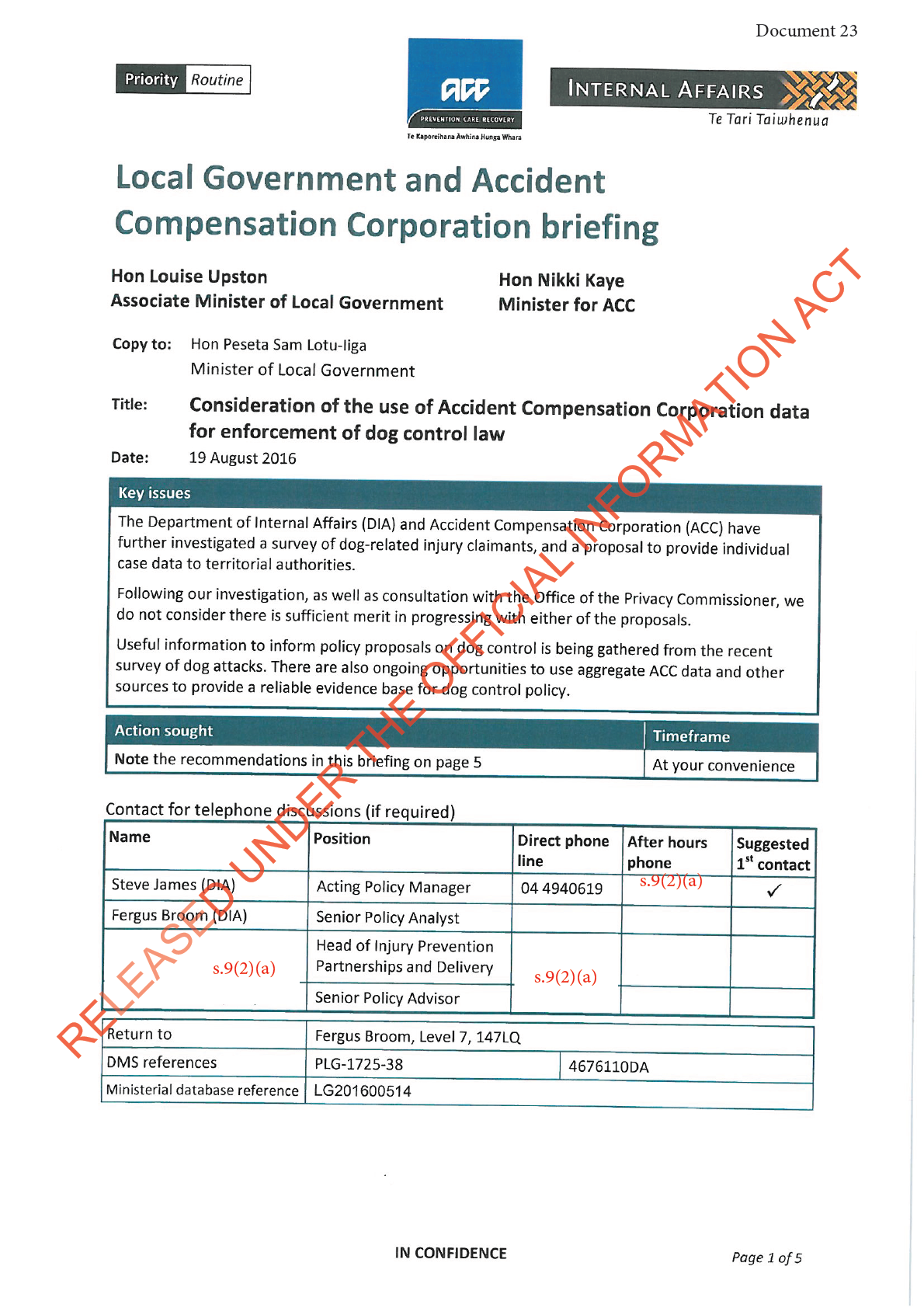
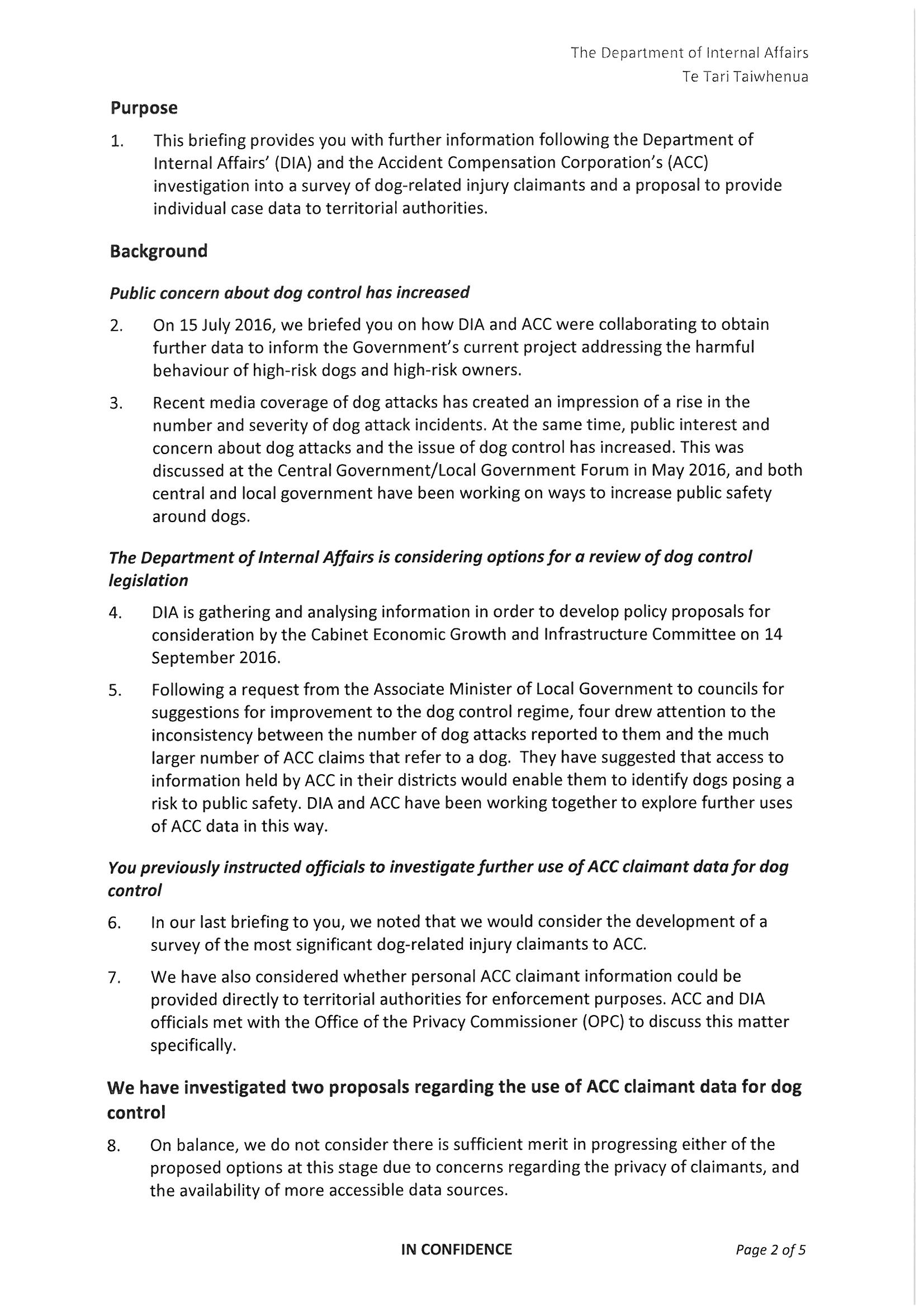
ACT
INFORMATION
E OFFICIAL
RELEASED
RELEASED UNDER THE OFFICIAL
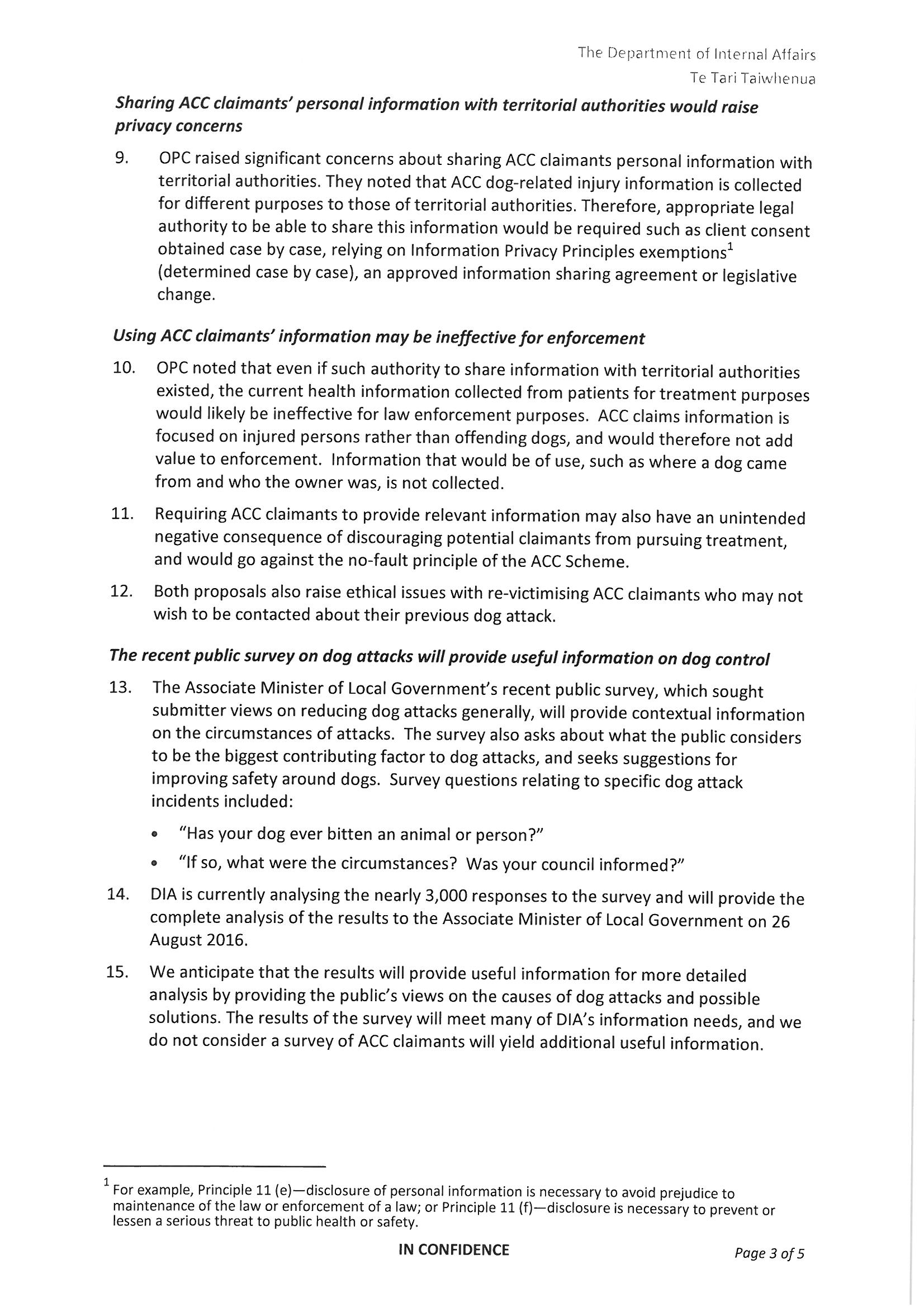
ACT
INFORMATION
E OFFICIAL
RELEASED
RELEASED UNDER THE OFFICIAL

ACT
INFORMATION
E OFFICIAL
RELEASED
RELEASED UNDER THE OFFICIAL
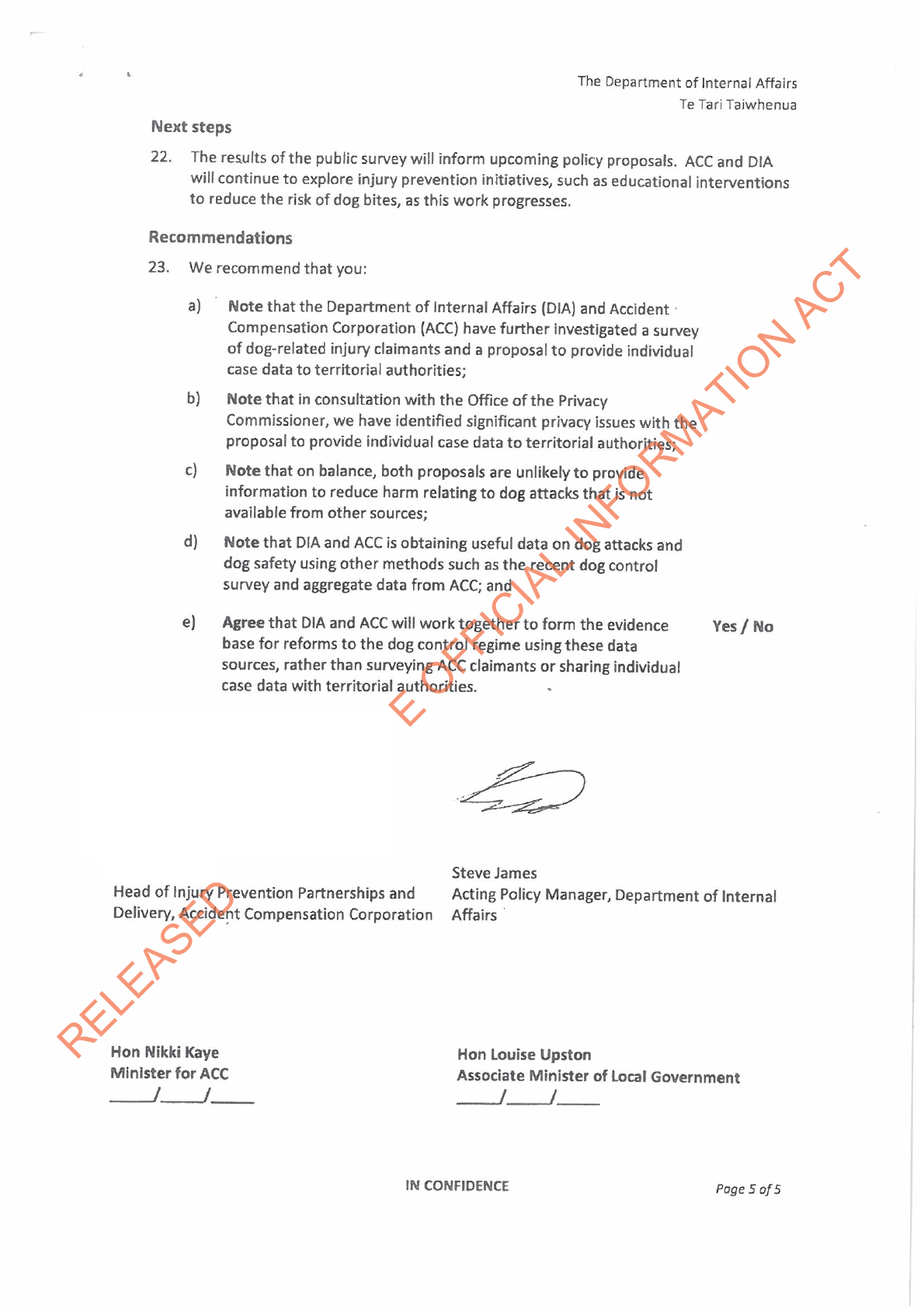
ACT
INFORMATION
s.9(2)(a)
RELEASED UNDER THE OFFICIAL
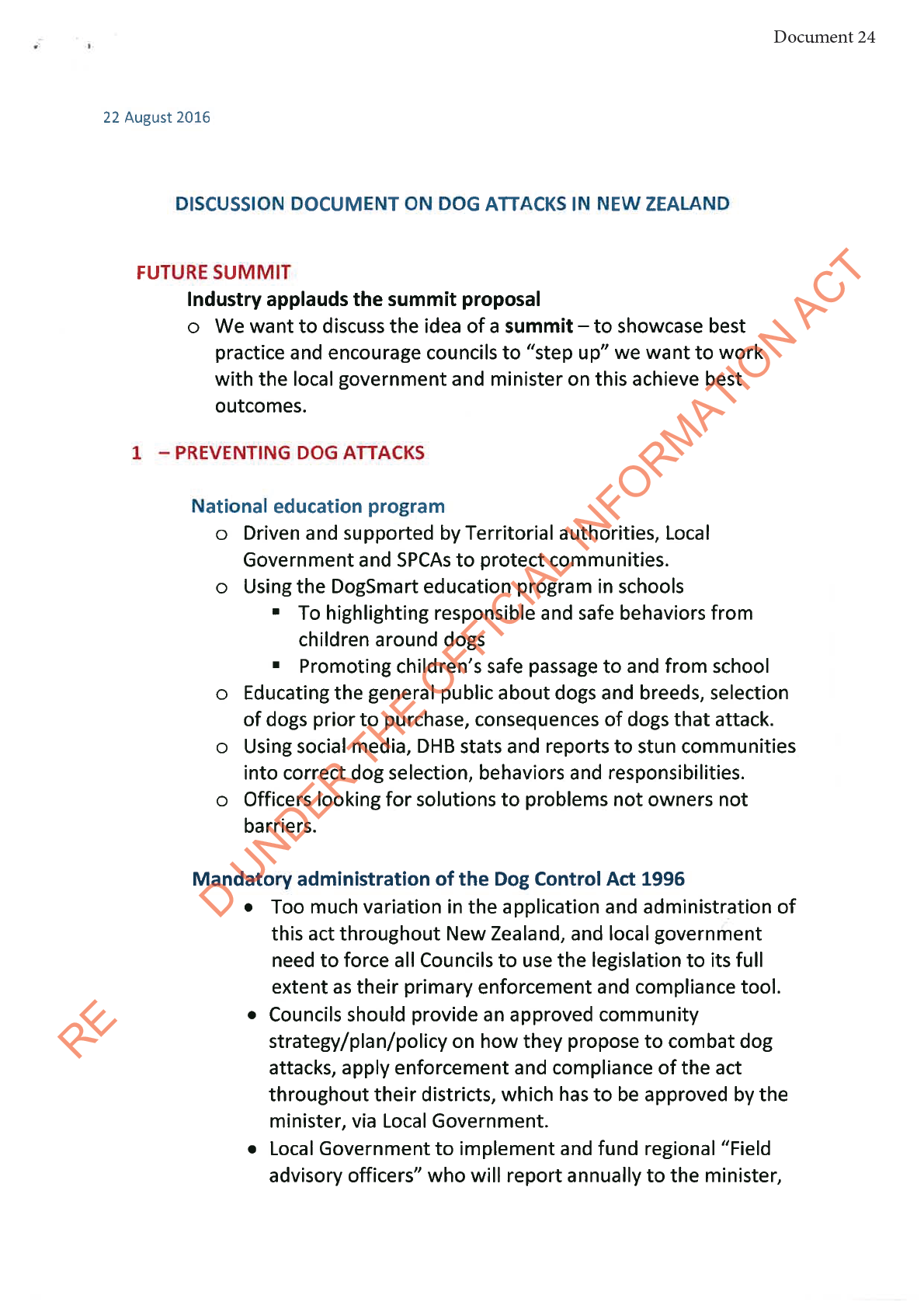
ACT
INFORMATION
RELEASED UNDER THE OFFICIAL

ACT
INFORMATION
RELEASED UNDER THE OFFICIAL

ACT
INFORMATION
RELEASED UNDER THE OFFICIAL
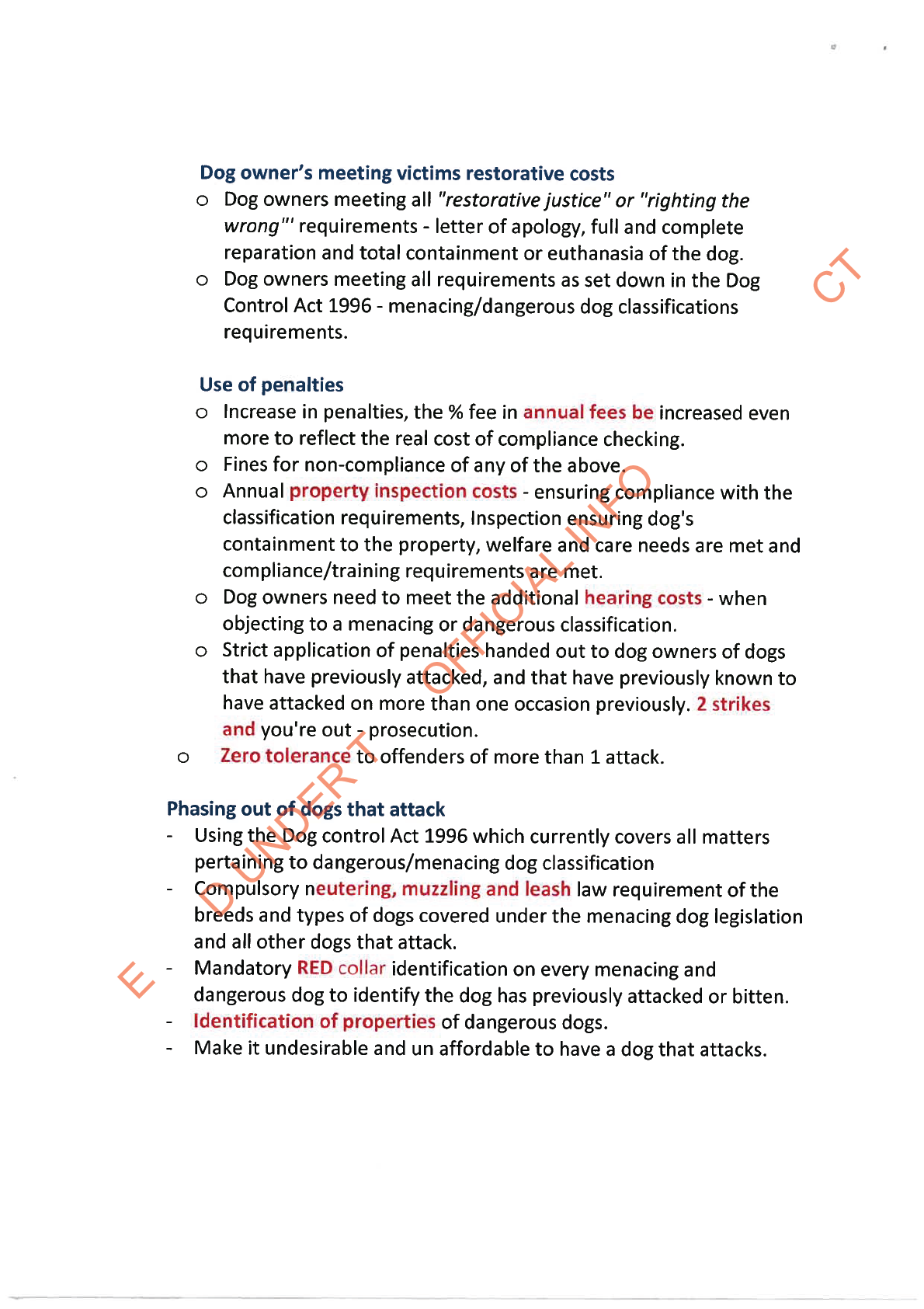
ACT
INFORMATION
RELEASED UNDER THE OFFICIAL
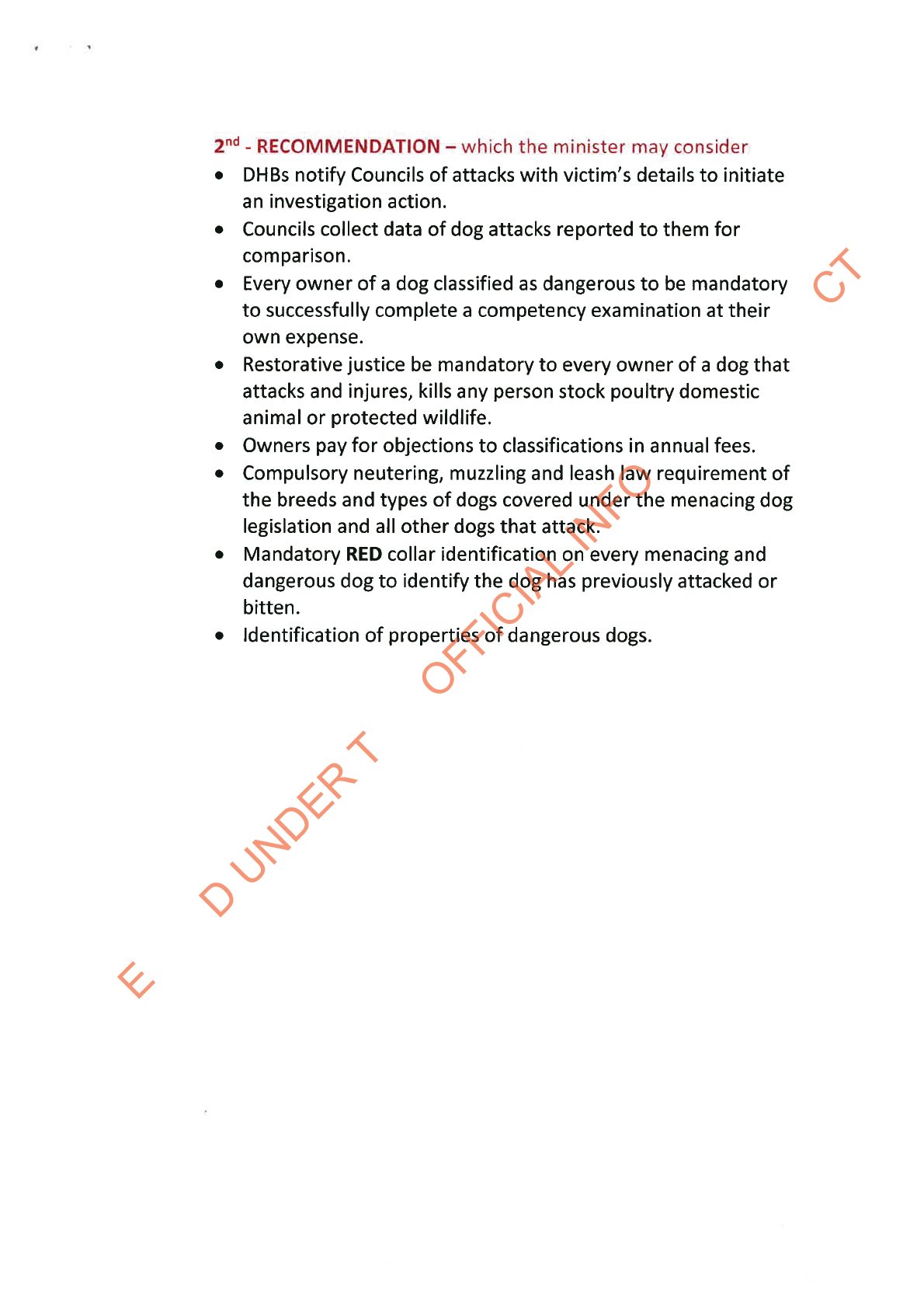
ACT
INFORMATION
RELEASED UNDER THE OFFICIAL

CT
ACT
INFO
INFORMATION
OFFICIAL
D UNDER T
E
RELEASED UNDER THE OFFICIAL
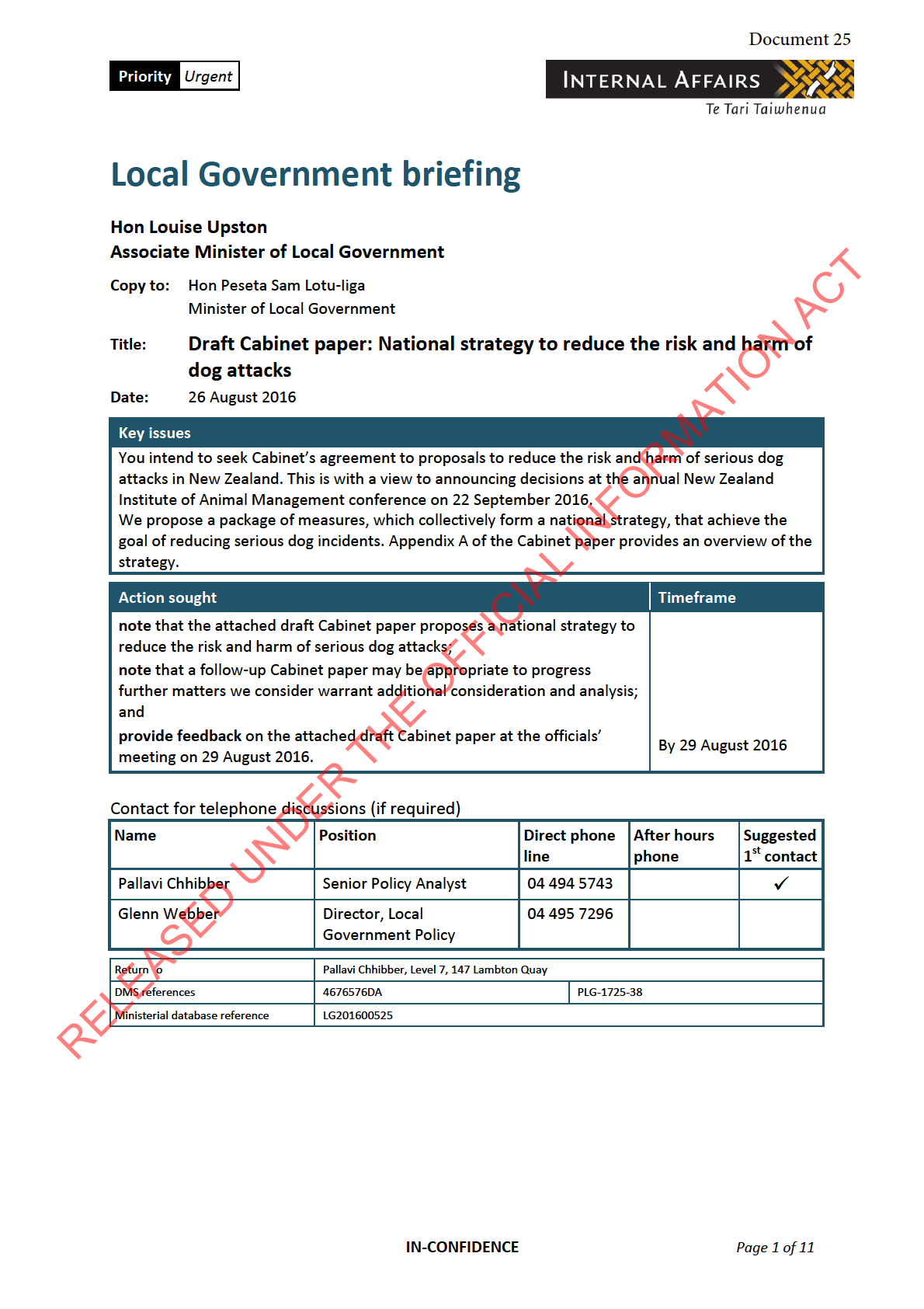
ACT
INFORMATION
s.9(2)(a)
RELEASED UNDER THE OFFICIAL
The Department of Internal Affairs
Te Tari Taiwhenua
Purpose
1.
The purpose of this briefing is to advise you on options to reduce the risk and harm of
dog attacks in New Zealand. It attaches:
An overview of the proposed strategy to reduce the risk and harm of dog attacks,
showing an indication of stakeholder support (Appendix A);
a draft Cabinet paper based on officials’ preferred options, for your review
(Appendix B);
the draft Regulatory Impact Statement supporting the Department’s analysis and
CT
proposed options (Appendix C); and
ACT
a summary of council and public feedback on proposed measures, and a media
release to announce the results and thank submitters (Appendix D).
Executive summary
2.
You intend to seek Cabinet’s agreement to proposals to reduce the risk and harm of
serious dog attacks in New Zealand. This is with a view to announcing decisions at the
annual New Zealand Institute of Animal Management conference being held on 22
September 2016.
3.
We propose a package of measures, which collectively form a national strategy, that
INFO
INFORMATION
achieve the goal of reducing serious dog incidents The draft Cabinet paper provides an
overview of the strategy.
Key findings that underpin our analysis on how to reduce risk and harm
4.
The Department’s analysis is summarised in the attached draft Regulatory Impact
Statement. That Regulatory Impact Statement is currently being assessed by the
OFFICIAL
Department’s internal regulatory impact analysis panel and is subject to additional
changes. We have provided it in draft form to act as supporting information as you
consider the proposed strategy.
5.
As part of our discussions with stakeholders and scan of literature, we have identified
the following key findings, which form the basis of the proposed policy position on
how to reduce the risk and harm of serious dog attacks.
Breed-specific legislation alone does not reduce the number of dog attacks
6.
International experience has indicates that breed-specific approaches have not been
D UNDER T
successful in reducing dog attacks, and the trend observed internationally is a move
away from this approach. Specifically, it shows that:
breed alone is not an appropriate indicator or predictor of aggression in dogs.
E Rather, certain breeds have a greater propensity for harm should they attack.
Focussing on particular breeds fuels the misperception that other dogs won’t bite;
RELEASED UNDER THE OFFICIAL
it is not possible to precisely determine the breed of the types of dogs targeted by
breed-specific legislation by visual identification or by DNA analysis; and
a breed-specific approach does not address the human element whereby dog
owners who desire a classifiable dog will simply substitute another breed of dog of
similar size, strength and perception of aggressive tendencies.
7.
Risk of attack and
harm of attack are two separate areas of policy action, which can
often get conflated. All dogs have potential for aggression and carry risk of attack; the
IN-CONFIDENCE
Page 2 of 11
The Department of Internal Affairs
Te Tari Taiwhenua
dog breeds and type in Schedule 4 of the Dog Control Act 1996 have a greater
potential to inflict significant harm. This is a sound rationale for placing greater
precautionary controls on the keeping of these dogs. However, other measures are
needed to address risk of attack.
Increasing controls and costs of ownership risks further disincentivising dog registration
8.
Dog registration is the cornerstone of effective dog control. This is because it links dog
control services to dog owners; allows for the appropriate placement of controls on
individual dogs; and provides a source of revenue for dog control activities. Dog
control policy needs to balance the need to have strict and appropriate controls in
CT
ACT
place for ‘higher risk’ dogs (which drives up compliance costs for their owners), with
the need to ensure dog ownership is not pushed further ‘underground’.
9.
Any additional cost may act as a discouragement from complying with requirements
such as registering dogs, or encourage irresponsible behaviours such as dumping dogs.
Having a dog classified as menacing is an important first step in being a responsible owner
10.
It is important that being the owner of a dog classified as menacing is not stigmatised,
and that policies around those owners, and their dogs, not are punitive in nature. This
is because the menacing classification system is designed to put extra protections
around those dogs so that they may be accepted into a society that is aware of and
INFO
INFORMATION
minimises the extra risk associated with these dogs. Having the appropriate controls
will mean ‘menacing’ dogs do not become ‘dangerous’ dogs. It may be more
appropriate to think of these dogs as ‘potentially dangerous’ rather than menacing.
Most dog incidents occur in the home; children are disproportionately involved in serious
dog attacks
OFFICIAL
11.
Both ACC claim and hospitalisation data show that most dog-related injuries and
incidents occur in the home. This finding is supported by findings overseas1 and what
we have heard from dog control officers we have met with.
12.
According to an analysis of hospitalisation data carried out by the University of Otago’s
Injury Prevention Unit, just under 30 per cent of the patients discharged for serious
dog bite incidents (excluding day patients) were under the age of 10. SPCA New
Zealand and other stakeholders we have met with also discussed the fact the children
are disproportionately affected.
D UNDER T
To be effective, policy tools need to be used in a phased approach
13.
There are a number of policy tools available to deal with dog control issues. These
nclude registration and licensing obligations; registration and licensing differential
Efees incentives; and classification of dogs or owners. Some of these tools we are
currently using; others could be adopted. All have merit in theory, but have practical
issues. We consider that the success of these further measures depends on the
RELEASED UNDER THE OFFICIAL
receiving environment being right.
14.
Currently dog control in New Zealand is significantly hampered by the high availability
of dogs. As such, ‘supply-side’ measures first need to be adopted to reduce the
1 Australian Veterinary Association
“Dangerous dogs – a sensible solution: Policy and model legislative
framework” (August 2012).
IN-CONFIDENCE
Page 3 of 11
The Department of Internal Affairs
Te Tari Taiwhenua
availability of high-risk classified and dangerous dogs. This combined with a societal
culture change process and more effective council action through development of best
practice, will mean the conditions are ripe for ramping up controls on dogs, owners
and breeders. This leads us to propose a package of amendments, which collectively
form a national strategy.
The attached draft Cabinet paper proposes a national strategy to reduce the risk
and harm of dog attacks
15.
The draft Cabinet paper provides an overview of the proposed national strategy. A
CT
table of the particular options proposed and not proposed, and the level of support
ACT
across stakeholders for our position is provided in
Appendix A.
16.
A financial contribution from Government will be necessary to run an effective
subsidised neutering programme. We are working with SPCA New Zealand and
Treasury to develop costings for a national neutering program, which will be included
in the final Cabinet paper.
There is a list of potential legislative issues the stakeholder have raised that
warrant investigation
17.
In addition to the measures we seek to put in place through the Cabinet paper, there
INFO
INFORMATION
may be additional measures that will further reduce harm caused by dog attacks. At
the later stages of stakeholder engagement, some issues that we consider warrant
further investigated were raised.
18.
OFFICIAL
s.9(2)(f)(iv)
D UNDER T
E
RELEASED UNDER THE OFFICIAL
IN-CONFIDENCE
Page 4 of 11
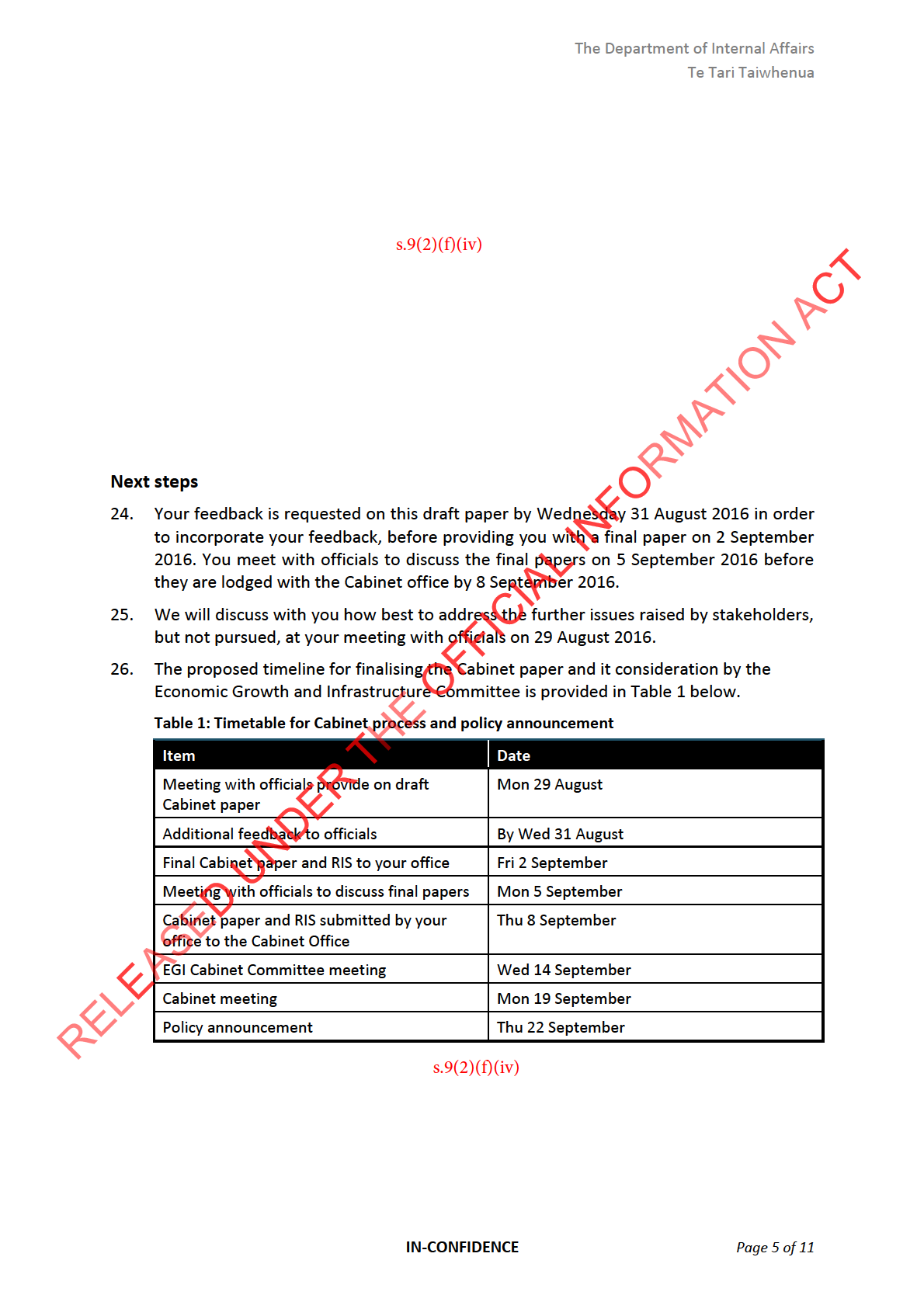
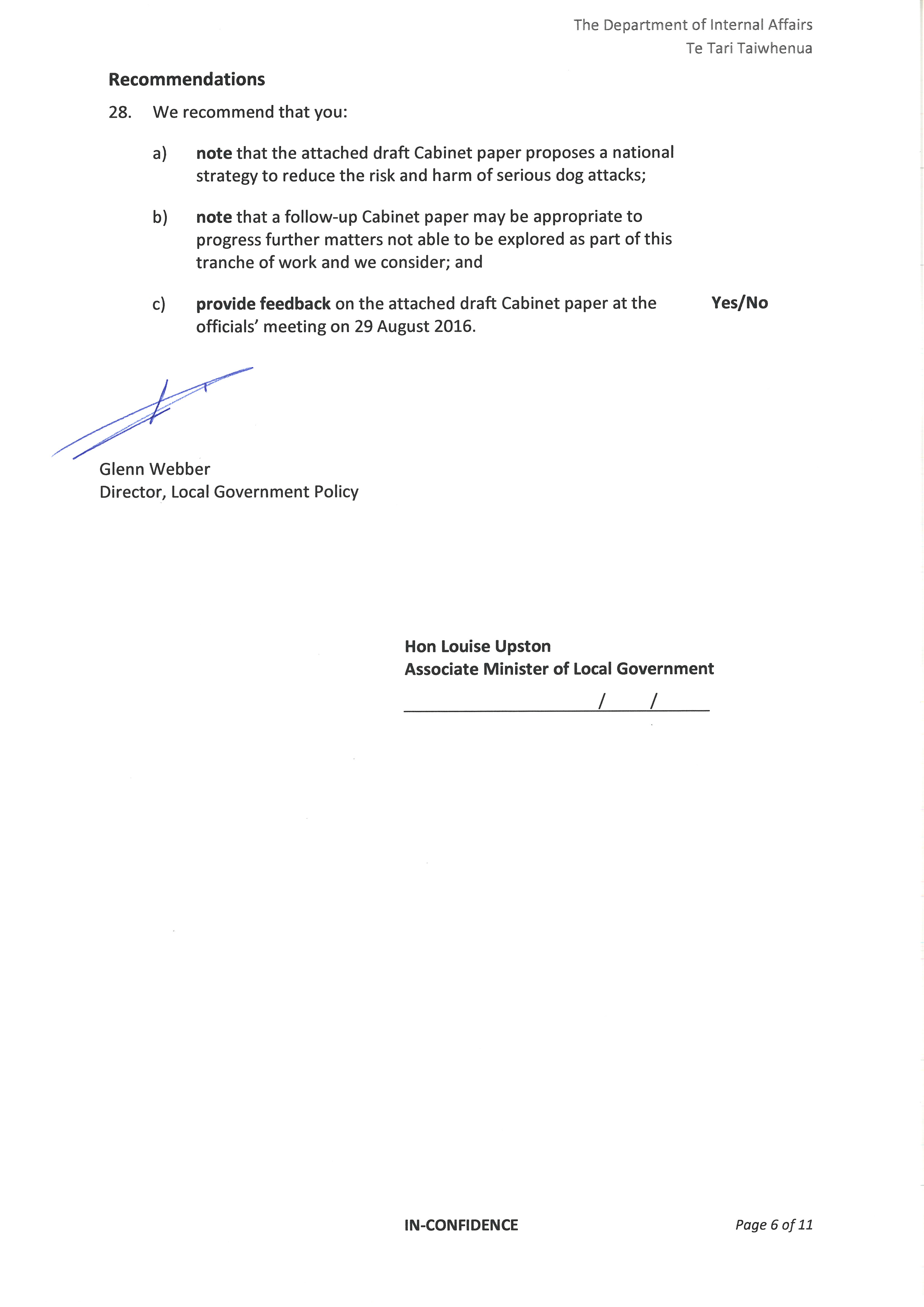
CT
ACT
INFO
INFORMATION
OFFICIAL
D UNDER T
E
RELEASED UNDER THE OFFICIAL
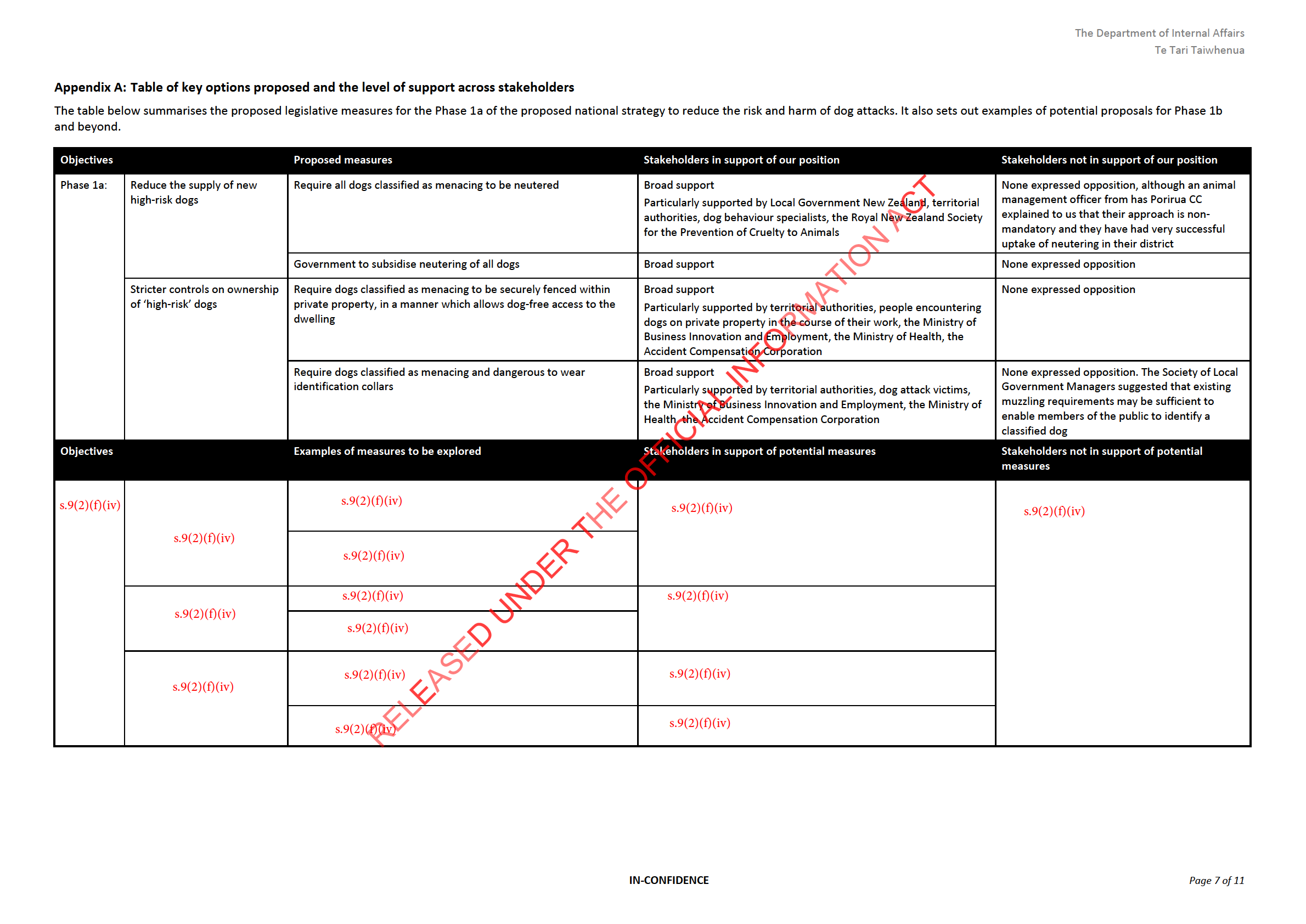

The Department of Internal Affairs
Te Tari Taiwhenua
Appendix B: Draft Cabinet paper
ACT
INFORMATION
INFORMATION
RELEASED UNDER THE OFFICIAL
IN-CONFIDENCE
Page 9 of 11
The Department of Internal Affairs
Te Tari Taiwhenua
Appendix C: Draft Regulatory Impact Statement
CT
ACT
INFO
INFORMATION
OFFICIAL
D UNDER T
E
RELEASED UNDER THE OFFICIAL
IN-CONFIDENCE
Page 10 of 11
The Department of Internal Affairs
Te Tari Taiwhenua
Appendix D: Summary report of survey results and council feedback, and draft
media release
CT
ACT
INFO
INFORMATION
OFFICIAL
D UNDER T
E
RELEASED UNDER THE OFFICIAL
IN-CONFIDENCE
Page 11 of 11
Regulatory impact statement: Proposals
to amend the Dog Control Act 1996
Agency disclosure statement
ACT
This regulatory impact statement has been prepared by the Department of Internal Affairs.
It provides an analysis of the options to reduce the risk and harm from dog attacks.
Ministerial direction is to review settings with a focus on high-risk owners and high-risk dogs.
This direction limits the scope of this work and the options explored in this analysis.
There is limited data available to assess the type and extent of problems with dog control
regulation, and in particular the scale and characteristics of serious dog attacks in New
Zealand. In particular, we do not have reliable data on the actual number of dogs in New
INFORMATION
INFORMATION
Zealand.
For information about dogs in New Zealand, we are reliant on the national dog database
(NDD). Information in the NDD is based on data uploaded from individual councils, and as a
result there can be irregularities in this information from year to year. In the past not al
councils had data in the NDD for every year, so totals in the NDD will be less than the actual
number of registered dogs. Where councils do not report for a
OFFICIAL data period, an estimate is
made based on data from previous or following years. As data prior to 2013 contains a
higher degree of under-reporting most of the analysis presented here is based on data from
2013 onward.
Steve Waldegrave
General Manager, Policy
/
/
RELEASED UNDER THE
RELEASED UNDER THE OFFICIAL
IN-CONFIDENCE
IN-CONFIDENCE
Contents
Agency disclosure statement .............................................................................................1
Contents ............................................................................................................................2
Executive summary .......................................................................................................... .3 CT
ACT
Objectives ................................................................................................................. .... ..3
Criteria ............................................................................................................ ... .............3
Status quo and problem definition ............................................................ ... ....................4
Problems to be solved ........................................................................ . .. ........................... 4
The causes of dog attacks ............................................................ .... .. .............................. 5
Problem Area 1: Inherent risk associated with dogs ............... . ........................................ 6
Options and impact analysis for Problem Area 1............. .. .............................................. 7
INFORMATION
Problem Area 2: Breeder and owner behaviour ........ .....................................................
INFO
11
Options and impact analysis for Problem Area 2.. ... ...................................................... 12
Problem Area 3: Council enforcement .................. .......................................................... 14
Options and impact analysis for Problem Area 3.............................................................. 15
Problem Area 4: Lack of public knowledge of dog behaviour and high-risk dogs ............ 16
Options and impact analysis for Problem Area 4.............................................................. 17
OFFICIAL
Summary of analysis of options for reducing harm and risk of dog attacks ........................ 18
Consultation ......................... .......................................................................................... 25
Conclusions and recommendations .................................................................................. 25
Implementation plan .................................................................................................... 26
Monitoring, evaluation, and review ................................................................................. 26
D UNDER T
E
RELEASED UNDER THE OFFICIAL
Page 2 of 27
IN-CONFIDENCE
Executive summary
1.
The Department has evaluated the status quo and a number of options to reduce the
risk and harm of dog attacks. The preferred options fal into four broad categories:
• Measures that transition New Zealand towards a lower risk dog population:
• Measures that encourage responsible dog ownership behaviour and discourage
negligent and reckless behaviour:
CT
• Measures that enhance the ability of territorial authorities to take effective
ACT
preventative and enforcement action against high-risk owners and high-risk dogs:
• Measures that help to protect individuals from becoming victims of dog attacks:
Requiring visual signifiers of dog classification, public education campaigns to
increase awareness of dog behaviour and safety.
Objectives
2.
The Dog Control Act 1996 aims to establish and maintain an appropr
INFO iate balance
INFORMATION
between the advantages of dog ownership to individuals and communities and the
protection of individuals and communities from dog attacks. The objectives of this
review are to further refine regulatory and non-regulatory settings to:
2.1
Improve community and individual safety from the threat and harm of dog
attacks;
OFFICIAL
2.2
Support the welfare of animals and the valuable role dogs play in our society
and individual wel -being; and
2.3
Increase effectiveness the dog control regime.
Criteria
3.
The following five criteria were used when assessing options.
•
Effective: the option achieves the desired outcomes and addresses the problems
D UNDER T
identified;
•
Efficient: the requirements minimise compliance costs and are no more than
necessary to achieve the outcomes sought;
E•
Equitable: the requirements are fair and are consistently applied; and
•
Clear and Transparent: people understand what is required of them and the basis
RELEASED UNDER THE OFFICIAL
of decisions.
•
Cost-effective: the option is a cost-effective expenditure of public funds
Page 3 of 27
IN-CONFIDENCE
Status quo and problem definition
4.
Any interaction between dogs and humans involves some risk. The central objective of
dog control policy in New Zealand is to strike an appropriate balance between the
advantages to individuals and communities of dog ownership and the protection of
individuals and communities from dog attacks.
5.
Dog control is regulated by the Dog Control Act 1996 (the Act). The Act was introduced
after a review of dog control in the mid-1990s which found that a serious dog control
CT
problem existed in New Zealand. The Act was amended substantially in 2003, and has ACT
been amended three times since then. The Act is implemented by city and district
councils with the support of their communities. The Act places increased restrictions
dogs according to characteristics typically associated with a particular breed or type, or
because of observed or reported behaviour.
6.
The Government is reviewing the policy settings around dog control to determine if
central and local government can do more to improve public safety around dogs. The
review aims to address concerns that serious dog attacks continue to happen with long
lasting impacts for victims and families. Serious dog attacks can be defined as an
interaction with a dog which results in death or serious injury (i.e. requiring
INFO
INFORMATION
emergency/hospital treatment) or which has the potential for such.
7.
There is limited data available to assess the nature and extent of problems with dog
control regulation, and in particular the scale and characteristics of serious dog attacks
in New Zealand. Available high-level evidence is as follows.
Problems to be solved
OFFICIAL
The rate of hospitalisation due to dog bites and number of ACC claims for dog-related
injury have been increasing significantly more than the number of registered dogs
8.
The number of registered dogs in New Zealand has been increasing slightly over the
past decade.
1 There were an estimated 492,741 registered dogs in 2007, and in 2016
there are an estimated 533,216 registered dogs
(Figure ). Over the last few years the
number of registered dogs per capita has remained stable, at about 12 dogs per 100
people. D UNDER T
9.
Ministry of Health data shows that the number of discharges for dog
bites has
increased by 53 percent from 457 in 2005 to 724 in 2015 (Figure 2). The rate of
hospitalisations by population is also increasing, with a rate of 15.8 hospitalisations per
E100,000 people in 2015. The annual rate of change is variable with discharges in the
last three years showing little change.
RELEASED UNDER THE OFFICIAL
1 The National Dogs database provides information on the number of registered dogs by councils. However,
prior to 2013 not al councils supplied data for every year. In addition, the number of registered dogs does not
reflect the total dog population in New Zealand.
Page 4 of 27
IN-CONFIDENCE
10. Otago University’s Injury Prevention Unit’s data shows that the number of
hospitalisations for
dog-related incidents increased by 72 percent from 276 in 2000 to
474 in 2014 (Figure 2).
2 Both the IPU and MoH data show a significant increase in
discharges in 2011, and a slowing/reduction in the rate of growth of hospitalisations
over the last few years.
11. ACC data on dog-related injury claims shows a 25 percent increase in the number of
active claims from 10,196 in 2006 to 12,695 in 2015 (Figure 3).
3 The total pay-out for
dog-related injuries from 2006 to 2015 was $34.860 mil ion. In 2015, the average cost CT
per claim was $407, and while there has been more annual variation in the average ACT
cost per claim than for the number of active claims, the cost of the average claim still
increased by 72 percent from 2006 to 2015.
Most dog incidents occur in the home; children are disproportionately involved in serious
dog attacks
12. Both ACC claim and hospitalisation data show that most dog-related injuries and
incidents occur in the home, fol owed by those that occur on the street (Figure 4). This
finding is supported by findings overseas.
4
13. According to the IPU data, just under 30 percent of the patients discharged were under
INFO
INFORMATION
the age of 10. In contrast the ACC claims data shows the peak rate of claims is for
clients in the 50-54 age range (Figure 5). This suggests that while more people may
claim for ACC injuries requiring treatment at older ages, the impact of dog-related
injuries appears to be greater on younger people. An analysis of media reports of
severe dog attacks supports the view that children were disproportionately involved in
serious incidents. Fifty-nine dog attack incidents involving 68 people injured were
OFFICIAL
reported on by the media over the last five years.
5 A third of the people injured were
under the age of nine.
14. Māori also appear to be a particularly affected group, as they tend to make up a higher
proportion of ACC claimants and hospitalisations than their percentage of the total
population (Figure 6). This is particularly evident for younger age groups (Figure 7).
The causes of dog attacks
15. The causes of dog attacks are known to be multifactorial. Literature identifies five key
interacting factors as determina
D UNDER T nts of the tendency of a dog to bite, namely:
• heredity (genes, breed),
• early experience,
E• socialisation and training,
• health (physical and psychological), and
RELEASED UNDER THE OFFICIAL
2 IPU analysis also originates from data col ected and supplied by MoH. But as wel as being subject to other
selection criteria, IPU data excludes day patients. Hence, the much lower numbers than for MoH data
presented here.
3 It should be noted that the ACC claims data is for dog related injuries and includes more than just ‘attacks’ or
‘bites’.
4 Australian Veterinary Association
“Dangerous dogs – a sensible solution: Policy and model legislative
framework” (August 2012).
5 275 media articles on dog attacks were examined from 2011 to 2016.
Page 5 of 27
IN-CONFIDENCE
•
victim behaviour.
16. Other factors include the sex and age of the animal, along with a range of other social
and environmental factors. International research findings are that:
•
Male dogs are 6.2 times more likely to bite than females
•
Undesexed dogs are 2.6 times more likely to bite than those that are neutered
•
Chained dogs are 2.8 times more likely to bite than unchained dogs
•
Dogs with “dominance aggression” are more likely to be 18-24 months old
CT
ACT
•
Dogs bred at home are less likely to bite, compared to those obtained from
breeders and pet shops
•
Dogs are more likely to bite the older they are when they are obtained
•
Biting dogs are more likely to live in areas of lower median income
•
Dogs are more dangerous when acting as a pack
17. There is no single contributing factor underlying al dog attacks. As such reducing the
risk and harm of attacks warrants action to address all of the five key factors described
above. In the absence of government intervention, the number and severity of dog
attacks is likely to continue. At the broadest level of analysis there are four main
INFO
INFORMATION
problem areas that have been identified with respect to dog control. These are
discussed below.
Problem Area 1: Inherent risk associated with dogs
18. The acceptance of dogs in our society means a baseline level of risk. However, a higher
level of risk arises due (i) intrinsic risk variation in the dog
OFFICIAL population owing to the
predispositions of particular breeds and (ii) the variation in potential for harm should a
dog attack, owing to the size of the dog.
Status quo
19. Councils have powers and responsibilities to declare a dog menacing or dangerous in
certain circumstances. Councils
may classify a dog as menacing dogs if it believes the
dog poses a threat to public safety because of its behaviour. Councils
must classify a
dog as menacing if there are reasonable grounds to believe it belongs wholly or
D UNDER T
predominantly to one or more of the breeds or types of dog that it is il egal to import
into New Zealand (under Schedule 4 of the Act). Currently these 'banned' breeds are
American Pit Bull Terrier, Dogo Argentino, Brazilian Fila, Japanese Tosa and Perro de
Presa Canario. Other breeds or types of dogs can be added to the list of restricted dogs
Eby Order in Council. Increased restrictions placed on dogs classified as menacing
include mandatory muzzling when in public, and councils
may require them to be
neutered.
RELEASED UNDER THE OFFICIAL
20. Dangerous dogs include those where an owner is convicted of an offence under 57A of
the Act, or where, on the basis of sworn evidence, the council believes a dog is a threat
to public safety or where the owner records in writing that it is a threat to public
safety. Dangerous dogs must be kept in a fenced part of the owner's property,
must be
muzzled, on a leash in public and neutered.
Page 6 of 27
IN-CONFIDENCE
21. The NDD records the number of registered dogs classified as menacing and as
dangerous under the Dog Control Act 1996. Since 2013 the number of menacing dogs
has steadily increased by six percent. The number of dogs classified as dangerous has
increased by two percent over the same period, although the rate of annual change is
more variable. The percentage of menacing and dangerous dogs in the total
population of registered dogs has remained at 1.6 percent for the last four years.
22. International experience has shown that breed-specific approaches has not been
successful in reducing dog attacks, and the trend observed is a move away from this
approach. Reasons why it is not successful include:
ACT
•
Breed alone is not an effective indicator or predictor of aggression in dogs and
focussing on particular breeds fuels the misperception that other dogs won’t bite.
•
It is not possible to precisely determine the breed of the types of dogs targeted by
breed-specific legislation by visual identification or by DNA analys s ATI
•
Breed-specific legislation ignores the human element whereby dog owners who
desire this kind of dog will simply substitute another breed of dog of similar size,
strength and perception of aggressive tendencies.
Pit bull-type dogs are over-represented in impounds, attacks, prosecutions, and euthanasi
INFORMATION
a
rates
23. While a number of the breeds in Schedule 4 are not known to exist in New Zealand,
there is anecdotal evidence that some have been imported undeclared and are
established here. With respect to the pit bul type dogs, councils’ evidence is that they
have increased greatly in number around the country. In the South Auckland region,
for the 2014/15 year, 37 percent of total impounds were considered Pit bull types and
crosses. Because of Auckland Council’s no rehoming policy for classified dogs as large
number of dogs are euthanised. Pit bull type dogs have been bred to eliminate
submission inhibition. As such, even if an individual pit bull type dog does not have
T
aggressive tendencies it has a latent potential for significant harm should an incident
arise where the dog becomes stressed/agitated.
Options and impact analysis for Problem Area 1
Mandatory neutering of al dogs classified as menacing (remove territorial authority
D UN
discretion)
24. At present, the territorial authorities have discretion as to whether they require the
AS
owner of a dog classified as menacing to neuter the dog. Approximately two-thirds of
councils have adopted mandatory neutering. Where such a policy is adopted, a non-
compliant owner can be fined (upon conviction) and the territorial authority can seize
RE the dog and retain it until the owner is willing to comply
RELEASED UNDER THE OFFICIAL, or dispose of the dog.
25. For dogs classified menacing
by breed, the import of such dogs is already banned. So
there is a clear rationale to require mandatory neutering. In fact, variation is this
respect undermines the current regime intent of restricting Schedule 4 breeds and
types to restrict these breeds in New Zealand. For dogs classified menacing
by deed,
neutering is understood to have behavioural advantages.
Page 7 of 27
IN-CONFIDENCE
26. As such, there is no need for council variation on this matter and national consistency
is desirable. Mandatory neutering would reduce the risk that the dog will commit a
serious attack; it wil also drive consistent practice across the country, and reduce costs
for territorial authorities (by streamlining and simplifying the process). Neutering also
supports animal welfare considerations as lowered aggression results in reduced risk
of the dog attacking and having to be euthanised.
27. Overal mandatory neutering would enhance the effectiveness of the dog control
regime, but there is a risk that some owners that wish to breed dogs that are
classifiable menacing or dangerous will try to evade collection of accurate breed
ACT
information via the registration system. It may also increase costs for councils if
owners become less likely to seek or accept classification of dogs where it is
appropriate.
28. This option increases equity between owners of menacing dogs as they are not
ATI
subjected to regional variation and there is 'one rule for all'. However, dogs that are
classifiable menacing by breed tend to be owned by those in lower socio-economic
groups. As such, in practice it may impose more costs on those who can less afford it.
29. This option is recommended as it meets objectives better than the status quo and is
cost-effective overall.
INFORMATION
Differential registration fee: Require territorial authorities to charge increased registration
fees of at least 50 percent for owning classified dogs
30. Differential fees are one tool for the creation of the right incentives among dog
owners. This option would seek to disincentivise ownership of dogs classified
menacing or dangerous, with the aim of transitioning to a lower-risk dog population,
with a lower potential for harm inflicted in the event of an attack.
31. To a certain extent, this option disincentivises ownership of classified (and Schedule 4)
dogs, thereby supporting trans
Tition to a lower-harm dog population. However, many
owners of Schedule 4 dogs do not intend to, or are not aware of the need to, register
their dog and pay fees. This option further disincentivises registration for that group.
Once those dog owners are identified, they are less likely to be able to register their
dog on the spot Therefore more dogs may have to be euthanised if owners become
aware they will have increased costs (especially if portrayed as punitive).
32. Many would see thi
D UN s option increasing equity as a significant amount of cost arises as a
result of classified/ classifiable dogs. But, owners of pit bul -type dogs tend to be in the
lower socio-economic demographic, who can less afford extra costs and may lose their
AS
dogs as a result. Further, their dogs may not have even exhibited aggressive
tendencies to attract extra cost. This option is not recommended.
D
RE
ifferential registration fees: Require territorial authorities to
RELEASED UNDER THE OFFICIAL
charge reduced/equal
registration fees for owning classified dogs
33. To be completed
Page 8 of 27
IN-CONFIDENCE
Differential registration fee: Require territorial authorities to provide a registration fee
reduction of at least 50 percent for dogs below 10 kilograms
34. As discussed in the option above, differential fees are a tool for the creation of the
right incentives among dog owners. Although al dogs/breed types and have aggressive
tendencies, the size of a dog plays a significant role in the potential harm that can be
inflicted. This option would seek to incentivise ownership of smaller sized dogs, with
the aim of transitioning to a lower-risk dog population, with a lower potential for harm
inflicted in the event of an attack.
35. This option incentivises ownership of smaller sized dogs, which have less potential for ACT
harm when an attack takes place, thereby supporting transition to a lower-harm dog
population. There are generally no animal welfare impacts, but may create an
incentive to withhold food for dog on the boundaries of the cut-off weight. There are
likely to be practical difficulties with this approach; dog control officers are often
ATI
registering unregistered dogs on the spot when they are identified. This approach
would potentially require them to carry scales. Also more councils are moving towards
online registrations, and such information is not able to be verified. There are already
inaccuracy issues with self-identified information in the system, such as breed of dog.
As this approach aims to reduce potential for harm but not aggressive tendencies, a
sense of inequity may also arise among some owners as a small dog displaying greate
INFORMATIONr
aggression would be endorsed over of dogs considered to be “gentle giants”.
36. It is also important to note that many councils already use fees incentives. Introduction
of another variable in the calculation may result in a lack of upfront clarity about how
fees are determined. The measure would however, be cost-effective.
37. This option is not recommended.
Differential registration fee: Require territorial authorities to provide a registration fee
reduction of at least 50 percent for dogs that have passed temperament and sociability
T
testing
38. As discussed in the options above, differential fees are a tool for the creation of the
right incentives among dog owners. This option would seek to incentivise ownership of
dogs with a lower individual risk profile, with the aim of transitioning to a lower-risk
dog population. Once temperament tested, councils could require repeat test as
appropriate (e.g. every three years), or once tested, the fees reduction may be
D UN
retained as a result of no complaints and infringements being registered against the
dog and their owner.
AS
39
This option incentivises ownership of non-aggressive dogs thereby supporting
transition to a lower-risk dog population. Also enables better behaviour-based
identification and appropriate classification of dogs. It is also considered to support
animal welfare considerations as it allows identification of high-risk dogs so that
RE
RELEASED UNDER THE OFFICIAL
appropriate care and control can be applied to them.
Page 9 of 27
IN-CONFIDENCE
40. It is important to note that many councils already use fees incentives. Introduction of
another variable in the calculation may result in a lack of upfront clarity about how
fees are determined. The measure would be cost-effective long term. However,
temperament is a new and evolving area requiring a level of training and expertise.
Testers/behaviourist used would need to be approved. Should this option be
progressed, there is likely to be a need to invest in training across New Zealand to build
up the skil -set. As such, appropriate lead-in time should be provided for councils to
implement such a policy.
41. This option is not recommended.
ACT
Introduce a sub-classification under menacing for dogs kept for an aggressive purpose
(hunting dogs)
42. Currently dogs can be classified as menacing by breed (section 33C) and by deed
ATI
(section 33E). An additional appropriate menacing classification for dogs may be as
menacing by purpose, for hunting dogs. These dogs are not only expected to have
aggressive tendencies, they will be selected by their owner as a dog able to inflict
significant harm. This option enables better behaviour-based identification and
appropriate risk-and harm-based classification of dogs INFORMATION
43. There is no New Zealand data on the extent to which dog attacks in New Zealand are
caused by hunting dogs, but it is appropriate that a higher-risk classification applies to
them in light of their purpose.
44. There may be practical difficulties as councils would be reliant on owners self-
identifying that a dog is being kept for an aggressive purpose.
45. This option is not recommended.
Ban on rehoming of dogs classified as menacing or dangerous
T
46. Currently many councils have a policy of the rehoming of dogs classified menacing or
dangerous from their council shelters. This option would make that rule consistent
across all councils and also prevent the SPCA from rehoming those dogs.
47. This is supportive in theory, as it lowers dog population with potential high-harm (and
high-risk for dogs classified by deed). But the extent to which this option would be
particularly effective depends on whether dogs, once classified and rehomed, are over-
D UN
represented in dog attacks. There is no data on this. It does not support animal welfare
considerations, particularly where a dog maybe well-adjusted and non-aggressive, but
classified by breed due to its potential for significant harm should there be an attack.
AS
Such a ban may disincentivise owners to seek or accept classification of dogs where it
is appropriate and to act responsibly when they can no longer adequately care for
their dog. People will also be less likely to surrender dogs to the council if there was
RE
RELEASED UNDER THE OFFICIAL
such a ban.
48. The option is however, likely to reduce shelter costs and be cost-effective.
49. This option is not recommended, as this is an area where local communities are best
placed to decide what is most appropriate for their context.
Page 10 of 27
IN-CONFIDENCE
Problem Area 2: Breeder and owner behaviour
50. As three of the five key factors in dog aggression involve a dog’s environment,
6
breeders and owners are crucial determinants of the risk associated with the dog. As
such, ingraining responsible attitudes to dog ownership is an important area of action.
Measures are needed to encourage responsible dog ownership and discourage
negligent and reckless behaviour through a combination of removing unnecessary
hurdles, providing incentives, and ensuring strong penalties.
ACT
Status quo
51. Dog owners have a number of obligations under the Dog Control Act 1996. These
include registering their dog with the local council before it is three months old or
when the owner receives the dog, and micro-chipping their dog when it is registered
ATI
for the first time (except for farm dogs), or if it has been classified as dangerous or
menacing.
52. Dog owners must also make sure the dog does not scare or injure any person or any
other animal and is kept under control at all times; and care for their dog – exercise it
and provide food, water and shelter.
INFORMATION
53. A dog owner must take al reasonable steps to ensure that the dog does not:
•
cause any nuisance to any other person, for example by constant barking, howling
or roaming
•
injure, endanger or cause distress to any stock, poultry, domestic animal or
protected wildlife
•
damage or endanger any property belonging to another person.
54. The penalty for owning a dog involved in an attack causing serious injury is up to three
years’ imprisonment and/or a fine of up to $20,000. The penalty for not registering a
T
dog is $300 as it the penalty for not micro-chipping a dog if required to do so.
55. There were 415,144 registered dog owners in New Zealand in 2016. This number has
increased by 7 percent since 2013. At the same time, the number of dogs per owner
has decreased by around 7 percent. This suggests that while more people are owning
dogs (and the total number of dogs has increased very slightly), people are tending to
own fewer animals.
D UN
56. Evidence from councils and animal management officers is that irresponsible dog
ownership is largely down (i) a lack of owner education about dog behaviour and how
to be
ASresponsible (ii) socio-economic factors resulting in an inability to meet extra
costs associated with responsible ownership, and (iii) unwilling non-compliant
attitudes among members of society. Often dogs may be kept specifically for
aggressive purposes, such for guarding property where illegal activity may be taking
RE
RELEASED UNDER THE OFFICIAL
place, for intimidation, or for the purpose of causing injury to other people or animals.
57. Anecdotal evidence is that animal welfare issues are also extensive.
6 Early experience, socialisation and training, health (physical and psychological).
Page 11 of 27
IN-CONFIDENCE
Options and impact analysis for Problem Area 2
s.9(2)(f)(iv)
ACT
ATI
INFORMATION
T
D UN
AS
RE
RELEASED UNDER THE OFFICIAL
Page 12 of 27
IN-CONFIDENCE
66. Owners of pit bull-type dogs tend to be in the lower socio-economic demographic,
who can less afford extra costs. This is another reason why a long lead-in time is
appropriate. There may be some confusion for owners who did not expect their dog to
be classified by breed or do not agree with the breed classification of their dog.
67. This proposal targets high-risk groups and encourages behaviour changes as opposed
to punitive action and is therefore recommended.
Extend fencing/containment requirements to al menacing dogs
ACT
68. Currently there are containment requirements on owners of dangerous dogs. This
option would extend that requirement to owners of menacing dogs. It would greatly
reduce the risk of people encountering high-risk dogs on private property, dogs
roaming/running off the property when provoked, and becoming agitated due to
chaining. Some councils may have such requirements in bylaws, but they are not
ATI
currently supported by legislation.
69. A fencing requirement increases compliance cost of ownership of a menacing dog, but
this is targeted at a high-risk population. This option is likely to be cost-effective, as a
larger part of dog control work is a result of dogs not being contained on their
property.
INFORMATION
70. This option is recommended.
Subsidise neutering
71. This option would incentivise neutering of dogs. Neutering is linked to lower
aggression and more neutered dogs wi l decrease unintended litters/ over-supply of
dogs. Councils consider this to be one of the most important actions to reduce the
likelihood of dog attacks, as a large number of litters and unintended and unwanted,
This lowers the value of these dogs and if one dog is impounded, often that owner will
T
simply get another dog. This also increases the number of dogs that continue to be
euthanised. As such, subsidised neutering also supports animal welfare considerations.
72. This option is likely to be cost-effective, however it is not possible to confirm this as it
is unclear how many dogs would need to be neutered for an effective reduction in
reproduction potential.
73. This option is recommended.
D UN
National educational campaign about social y responsible dog ownership
AS
74. Councils considered people to not be very well informed about what socially
responsible dog ownership is. Owner behaviour is known to be a significant
contributor to dog attacks. Socially responsible owners result in more wel -adjusted
RE dogs with less risk of dog attacks, and it reinforces the v
RELEASED UNDER THE OFFICIALalue of dogs in society.
Investment in upfront education and prevention would require less enforcement
action and costs of non-compliance for owners due to greater awareness and culture
change. How much it would cost to carry out an effective public education campaign is
unclear. However, carrying out such a campaign at the national level is considered to
be more cost-effective and individual efforts among councils.
75. This option is recommended.
Page 13 of 27
IN-CONFIDENCE
Problem Area 3: Council enforcement
Status quo
76. Enforcement of the Dog Control Act 1996 is the responsibility of territorial authorities.
Territorial authorities are also responsible for setting dog control policy in their area:
this includes setting registration and other fees and stipulating leash-free exercise
areas and areas where dogs must be kept on a leash or where they are prohibited
(except for disability assist dogs).
ACT
77. Dog control officers can seize dogs that are not under direct control of a person and
are free to leave the property along with dogs that are straying, unregistered, behaving
aggressively, or not receiving adequate food, water or shelter.
78. Every council must keep a record of all dogs registered. All councils are required to
ATI
provide information on the dog and its owner along with its microchip number (if it has
one) to the national dog database.
79. There are also mandatory annual reporting requirements on councils under s10A of
Dog Control Act 1996.
INFORMATION
There are potential y a large number of unregistered and un-microchipped dogs in New
Zealand; unregistered dogs are over-represented in impounds and attacks
80. Risk associated with dogs is greatly increased by not having appropriate controls on
dogs. Applying the appropriate controls to dogs requires dogs being ‘in the system’
rather than ‘underground’.
7 Dog registration is considered to be the cornerstone of
effective dog control because it links dog control services to dog owners, allows for the
appropriate placement of controls on individual dogs, and provides a source of
revenue for dog control activities. Micro-chipping for identification is an important
part of connecting a particular dog to an incident and prior incidents that may have
T
occurred.
81. The recent Auckland Council amnesty which resulted in over 1500 unregistered dogs
brought forward for registration indicates that the current dog registration system is
not effectively enforced. There are 100,000 registered dogs in Auckland and Auckland
Council estimates that there are approximately another 100,000 unregistered dogs.
There are indications there is a similar problem of under-registration across the
D UN
country, although evidence is limited.
Councils are not receiving accurate information about dog attacks in their districts
AS
82
Councils can only investigate attacks they are made aware of, generally by the victim
or someone else involved in the incident. There are no mandatory requirements on
health professionals or agencies (such as the Accident Compensation Corporation) to
RE
RELEASED UNDER THE OFFICIAL
notify councils of an incident they become aware of. Councils have noted that without
accurate information about the presence and behaviour of dogs in their district, it is
not possible for councils to effectively address high-risk dogs or owners.
7 It is for this reason that any sort of ban on ownership of dog types or breeds is not considered a feasible
option and therefore is not assessed alongside other options in this analysis.
Page 14 of 27
IN-CONFIDENCE
Councils are not going through the full prosecution process due to the expense of this
process and limited resources to work with
83. There are members of society for whom infringements are not an effective deterrent.
However, prosecutions may not be able to be taken as much as territorial authorities
would like, as they do not have the budget.
Options and impact analysis for Problem Area 3
ACT
Mandatory photos for national dog database for all dogs classified as menacing or
dangerous
84. This option would make it easier for councils to identify classified dogs moving across
council boundaries. It would also promote the taking of photos (important of
ATI
evidentiary purposes) of classified dogs where currently this may not be council
practice. Currently many councils are taking photos, which they store on their council
systems but they are unable to upload them to the NDD. Making it mandatory would
result in national consistency which is necessary otherwise the approach would be of
limited value.
INFORMATION
85. There would be cost to councils and government to modify registers for the additional
functionality in the national dog database to incorporate photos. However, because
the NDD has already been established, this measure is considered to be cost-effective.
This option is not recommended.
Produce best practice guidance for increasing registration uptake in collaboration with the
sector
86. This option would mean the production of best practice guidance, in col aboration with
the sector. Sharing knowledge on increasing registration uptake supports less well-
T
resourced councils to take appropriate action to bring dogs ‘into the system’ so
appropriate controls can be applied to dogs.
87. A best practice guidance approach reduces the need for a ‘one size fits al ’ type
legislative approach to increasing registration uptake which may prove burdensome
for some councils and decreases room for innovation. This option is recommended.
D UN
Regulation on sale of dogs - obligation to carry out initial registration and micro-chipping
before sale
AS
88
Never known unregistered dogs overrepresented in dog attacks and pounds. Currently
there are obligations on an owner to register and microchip their dog. This option
would also place obligations on a seller to ensuring registration and micro-chipping
RE have been carried out. This option aims reduce the numbe
RELEASED UNDER THE OFFICIAL r of unknown unregistered
dogs. However, as a large number of litters are unplanned and unwanted, owners may
not be aware of obligations. A large number of ‘sales’ are informal. There is a risk that
such a policy could result in ‘backyard’ euthanising of unwanted litters. Therefore such
a rule may be hard to enforce and potentially force sales further ‘underground’. This
option is recommended for implementation at a later date.
Page 15 of 27
IN-CONFIDENCE
Produce best practice guidance for working with other agencies to increase territorial
authorities’ access to relevant information to carry out enforcement activity
89. This option would mean the production of best practice guidance, in col aboration with
the sector. Some councils have excellent working relationships with other agencies
such as the Police, and Child, Youth and Family. This is because there are shared
interests and an understanding that there are efficiencies in working together. This is
an area of practice, rather than policy and therefore insights into how to work with
other interested agencies may not be actively shared across the local government
sector. Sharing knowledge on information-sharing supports less wel -resourced
ACT
councils to form effective relationships with other agencies to maximise benefits
90. A best practice guidance approach reduces the need for a ‘one size fits al ’ type
legislative approach to information-sharing which may prove burdensome for many
councils. Such a measure is also likely to be cost-effective.
ATI
91. This option is recommended.
INFORMATION
s.9(2)(f)(iv)
94. This option is not recommended.
T
Problem Area 4: Lack of public knowledge of dog behaviour
and high-risk dogs
95. The remaining factor determinant of whether a dog will attack is victim behaviour.
96. Because of the inherent risk associated with dogs, there will always be potential
D UN
victims who are vulnerable to attack. Risks can be mitigated by having enhancing the
ability of the public to be safer around dogs. People often do not know when they may
be ent
ASering a high-risk situation, how to recognise and deal with an imminent attack or
what to do when one has begun. At an even more basic level, only a smal proportion
of people know how to interact with dogs and understand dog behaviour.
RE
RELEASED UNDER THE OFFICIAL
Status quo
97. Anecdotal evidence from council officers suggests that victim behaviour is a significant
contributor to outcome. Children are often running away, and children and adults alike
may often be taunting an already somewhat agitated dog. Children and often
unsupervised by an adult when they are attacked.
Page 16 of 27
IN-CONFIDENCE
Options and impact analysis for Problem Area 4
National public education campaigns to increase awareness of dog behaviour and safety
98. The general public is not very wel informed about dog behaviour and how to be safe.
Victim behaviour is known to be a significant contributor to dog attacks according to
international findings. Investing in education and prevention would require less
enforcement action and costs of non-compliance for owners due to greater awareness
and culture change.
ACT
99. How much it would cost to carry out an effective public education campaign is unclear.
However, carrying out such a campaign at the national level is considered to be more
cost-effective and individual efforts among councils. This option is recommended.
ATI
s.9(2)(f)(iv)
This option is
INFORMATION
recommended.
Mandatory special collars to identify classified dogs
101. Supports. Enables the public and visitors to private property at risk of attack to be wel
informed of risk, as well as those out in public where the dog is not wearing a muzzle.
The requirement to where a signifying collar could potential y result in stigma that
results in less socialisation for the dog, but unclear to what extent this is likely. Also,
currently menacing and dangerous dogs are required to wear a muzzle when in public.
Therefore it could be argued this requirement is more than the minimum necessary, as
T
a muzzle is also a visual sign. However, it is not clear to what extent the muzzling
requirement is complied with. A large number of infringements are issued each year
for failure to muzzle.
102. This option adds compliance cost of purchasing a collar, however is considered to be
cost-effective. This option is recommended.
D UN
Mandatory display of signs on properties housing dogs classified as menacing or
dangerous
AS
103. This option enables visitors to a property where they are at risk of attack to be well
informed of risk. As most attacks occur in the home, this option is considered to be the
right area for action to reduce risk of dog attacks. The option adds compliance cost for
RE owners of purchasing a sign. It may also be more than the
RELEASED UNDER THE OFFICIAL minimum necessary given
proposal 2.3 (extend fencing requirements). As such, this option is not recommended.
Page 17 of 27
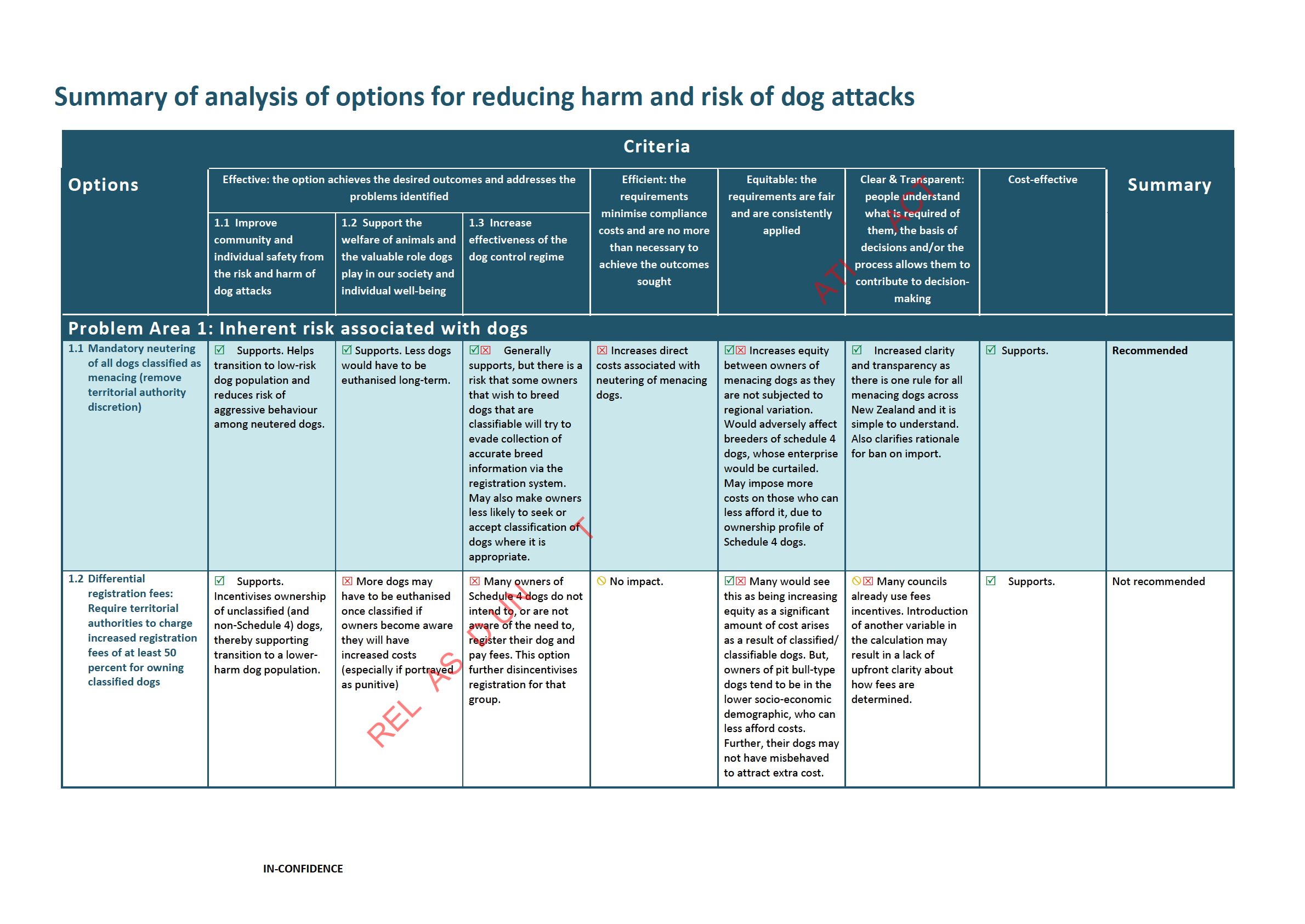
ACT
INFORMATION
RELEASED UNDER THE OFFICIAL
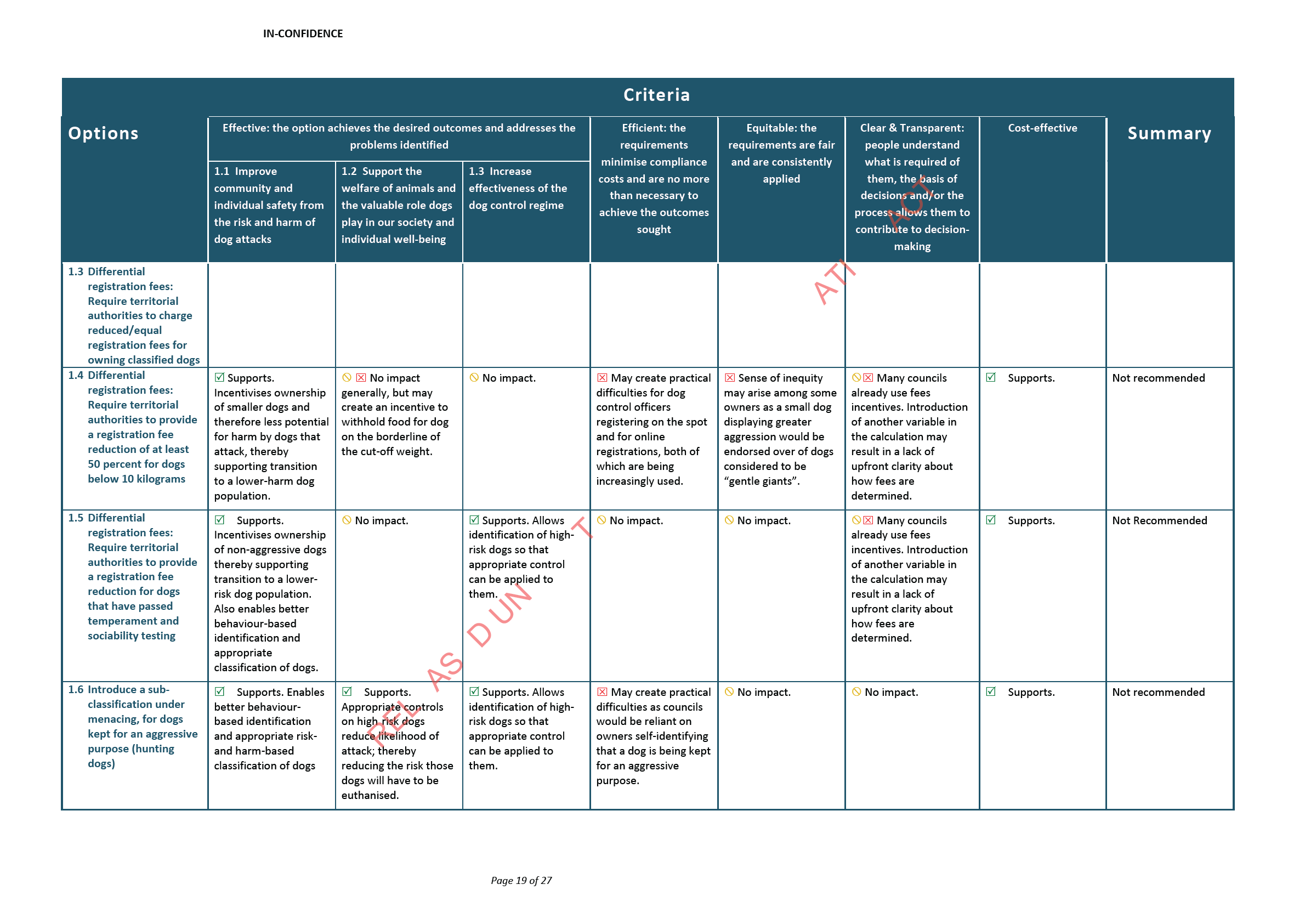
ACT
INFORMATION
RELEASED UNDER THE OFFICIAL

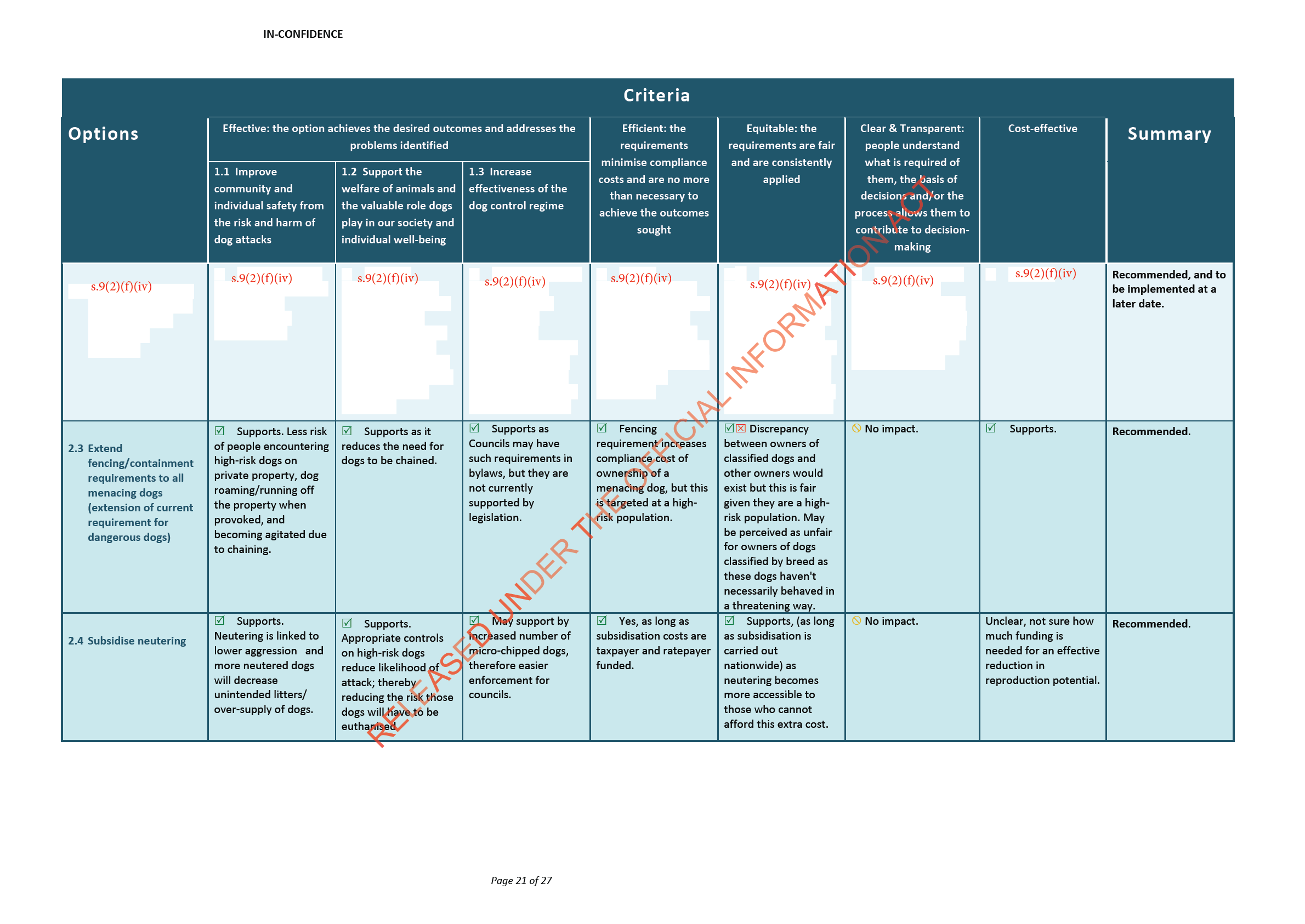
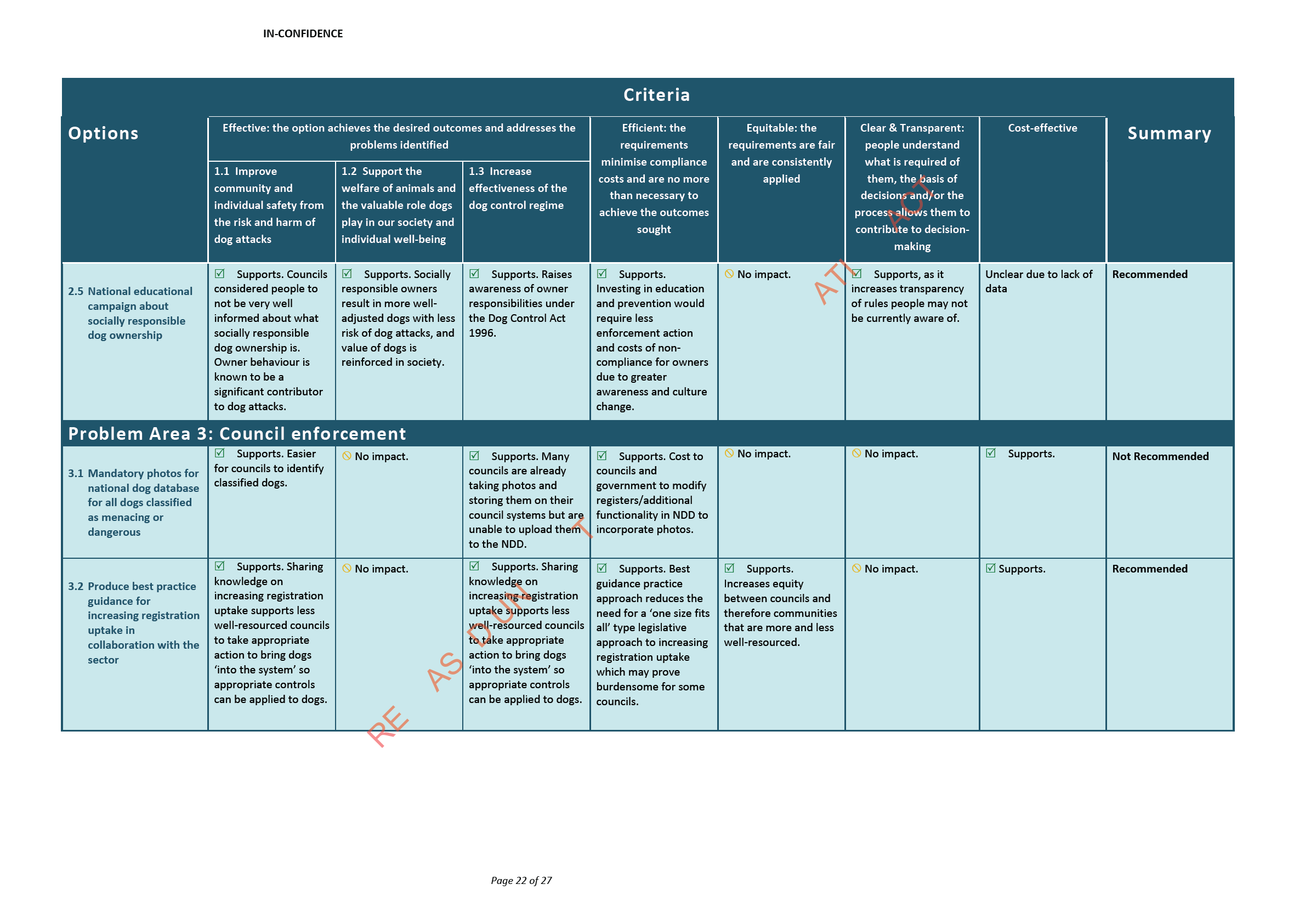
ACT
INFORMATION
RELEASED UNDER THE OFFICIAL
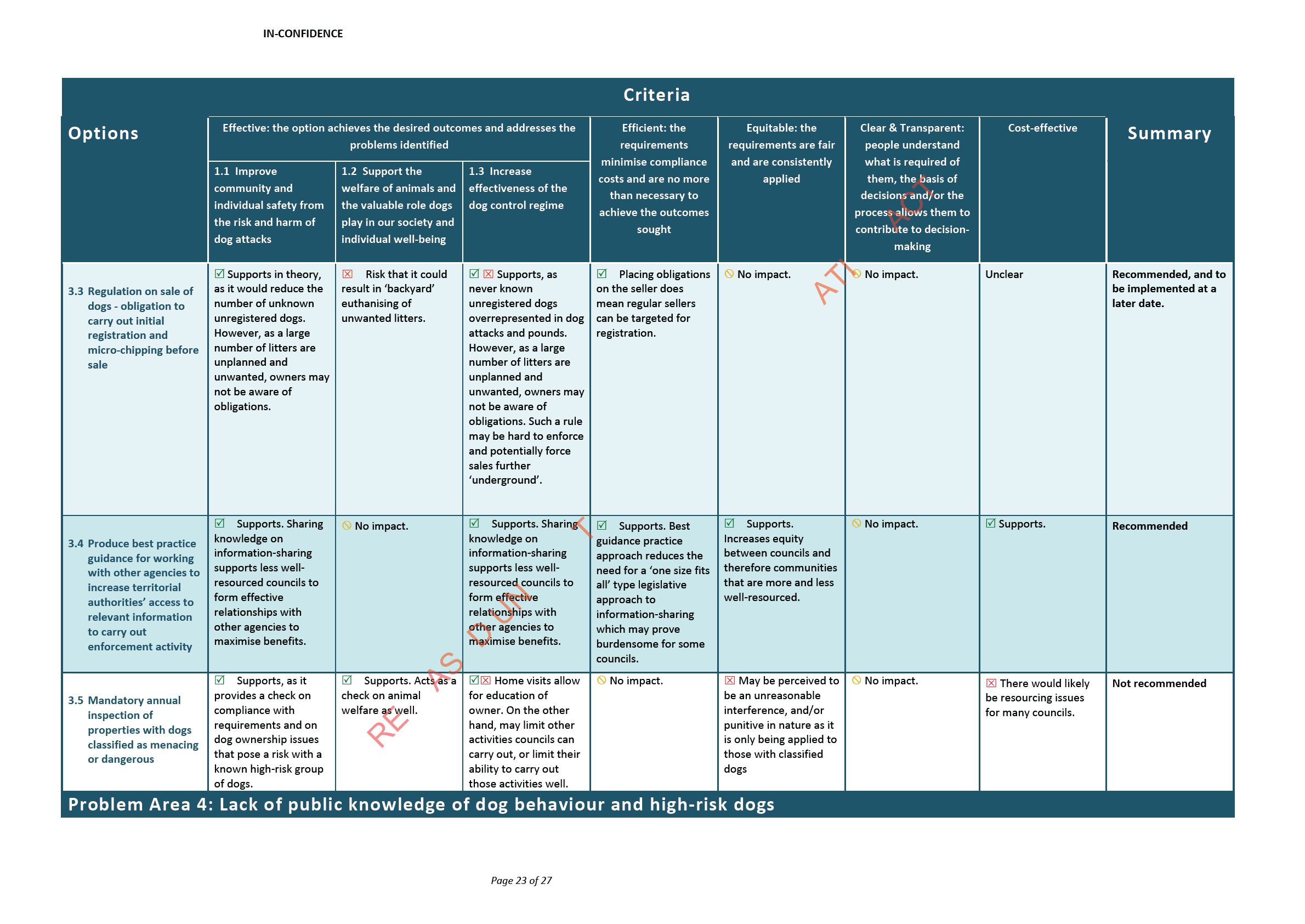
ACT
INFORMATION
RELEASED UNDER THE OFFICIAL
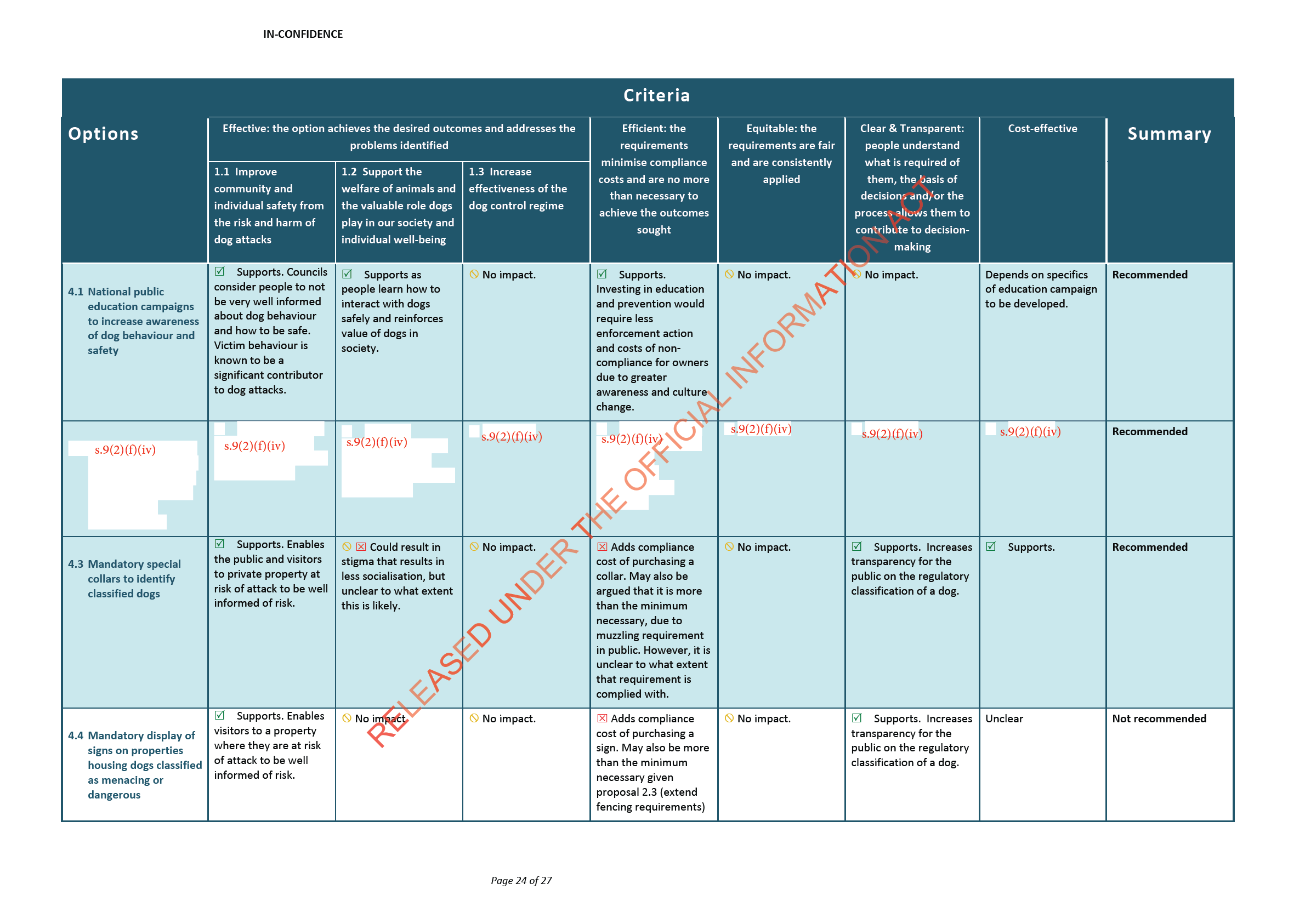
Consultation
4 In the preparation of these proposals, a range of external stakeholders were also
consulted, including Local Government New Zealand, the Society of Local Government
Managers, Auckland Council, the New Zealand Institute of Animal Management
(previously known as the New Zealand Institute of Animal Control Officers), the New
Zealand Association of Plastic Surgeons, the New Zealand Kennel Club, Federated
Farmers of New Zealand, Rural Women New Zealand, the Veterinary Council of New
ACT
Zealand, Dog behaviour experts, Trade Me, and the Royal New Zealand Society for the
Protection of Animals the Pit bul Club, and the American Staffordshire Terrier Club.
5 We also undertook targeted engagement with victims of dog bites and dog owners in
Auckland and Wel ington. Officials also met with, farmers and other members of the
ATI
rural community, and animal control officers. An online engagement survey was used to
capture the sentiment of the general public about areas for improvement to the dog
control regime. The two week survey period resulted in over 3000 responses.
6 This engagement enabled officials to gain some understanding of the nature and the size
of dog control problems and to identify potential solutions. INFORMATION
Conclusions and recommendations
7 The Department recommends the following package of options:
Measures that transition New Zealand towards a lower risk dog population:
• Mandatory neutering of all dogs classified as menacing (remove territorial
authority discretion)T
• Differential registration fees: Require territorial authorities to provide a
registration fee reduction for dogs that have passed temperament and
sociability testing
• Introduce a sub-classification under menacing, for dogs kept for an aggressive
purpose (hunting dogs)
D UN
Measures that encourage responsible dog ownership behaviour and discourage
negligent and reckless behaviour:
•
AS s.9(2)(f)(iv)
• Extend fencing/containment requirements to al menacing dogs (extension for
RE
requirement for dangerous dogs)
RELEASED UNDER THE OFFICIAL
• Subsidise neutering
• National educational campaign about socially responsible dog ownership
Measures that enhance the ability of territorial authorities to take effective
preventative and enforcement action against high-risk owners and high-risk dogs:
• s.9(2)(f)(iv)
Page 25 of 27
• Produce best practice guidance for increasing registration uptake in
collaboration with the sector
• Produce best practice guidance for working with other agencies to increase
territorial authorities’ access to relevant information to carry out enforcement
activity
Measures that help to protect individuals from becoming victims of dog attacks:
• National public education campaigns to increase awareness of dog behaviour
and safety
ACT
•
s.9(2)(f)(iv)
• Mandatory special collars to identify classified dogs
ATI
8 These options are considered to be able to reduce the risk and harm of dog attacks.
Implementation plan
INFORMATION
9 These proposals wil be implemented as part of three phases of work.
•
Legislative phase: a one to two year process to amend the Act and develop
regulations to address deficiencies in the current dog control legislation;
•
Best practice phase: a one to two year process (concurrent to the legislative
phase), led by the local government sector, to develop best practice guidance for
the local government sector about mplementation of the Act, amendments, and
associated regulations; and
•
Public education phase: a five to ten year process, led by central and local
government, to influence societal change in attitudes about responsible dog
T
ownership and safety around dogs
10 Phases 2 and 3 wil be carried out in col aboration with local government and other
stakeholders.
Monitoring
D UN
, evaluation, and review
11 Monitoring will continue to occur as it does currently via the annual collation and release
of statis
AStics relating to dog control from other agencies and the national dog database.
Annual councils dog control reports prepared under section 10A of Dog Control Act 1996
will also be reviewed to ascertain a picture of the trends.
12
RE There are no plans for a future review of proposals at this s
RELEASED UNDER THE OFFICIAL tage. There is no legislative
requirement to conduct regular reviews and such a review will likely occur as priorities
allow.
Page 26 of 27
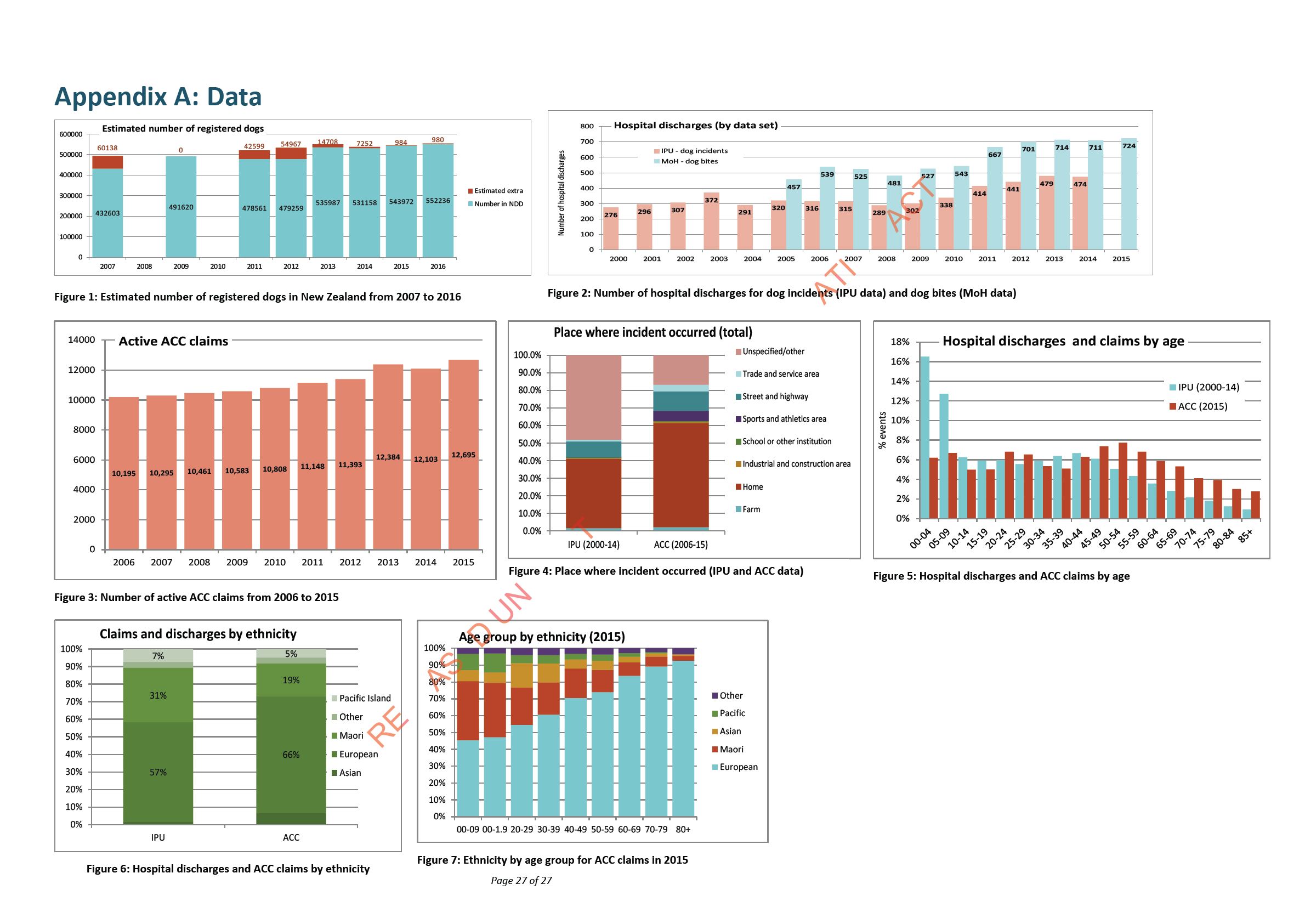
ACT
INFORMATION
RELEASED UNDER THE OFFICIAL
DRAFT Media Release
Hon Louise Upston
Associate Minister of Local Government
29 August 2016
Over 3000 submissions received on reducing dog ACT
attacks
Associate Minister of Local Government Louise Upston today expressed thanks to
the more than 3000 people who made submissions on New Zealand’s dog control
ATI
laws.
“This huge response shows how passionate Kiwis are about our dogs and dog
safety.”
Of the 3,096 people who responded to the survey, 84% were dog owners and 48%
INFORMATION
were particularly concerned about dog attacks.
Respondents overwhelmingly identified dog owners and poor education about dog
behaviour as the two biggest contributing factors to dog attacks.
“Interestingly, despite being predominantly dog owners, respondents typically
considered dog owners to be problematic because bad owners created dangerous
dogs and dangerous situations.”
“Respondents typically saw education about dog behaviour and dog ownership as
T
the best ways to reduce dog attacks.”
“Of particular interest given the disproportionate number of child victims were
submissions highlighting that many people and especially children do not know how
to safely interact with dogs and often misunderstand dogs’ behavioural signals.”
The Government will consider the feedback in detail as part of its wider assessment
D UN
of New Zealand’s dog control regime.
ENDS
AS
Key statistics follow over…
RE
RELEASED UNDER THE OFFICIAL
Page 1 of 3
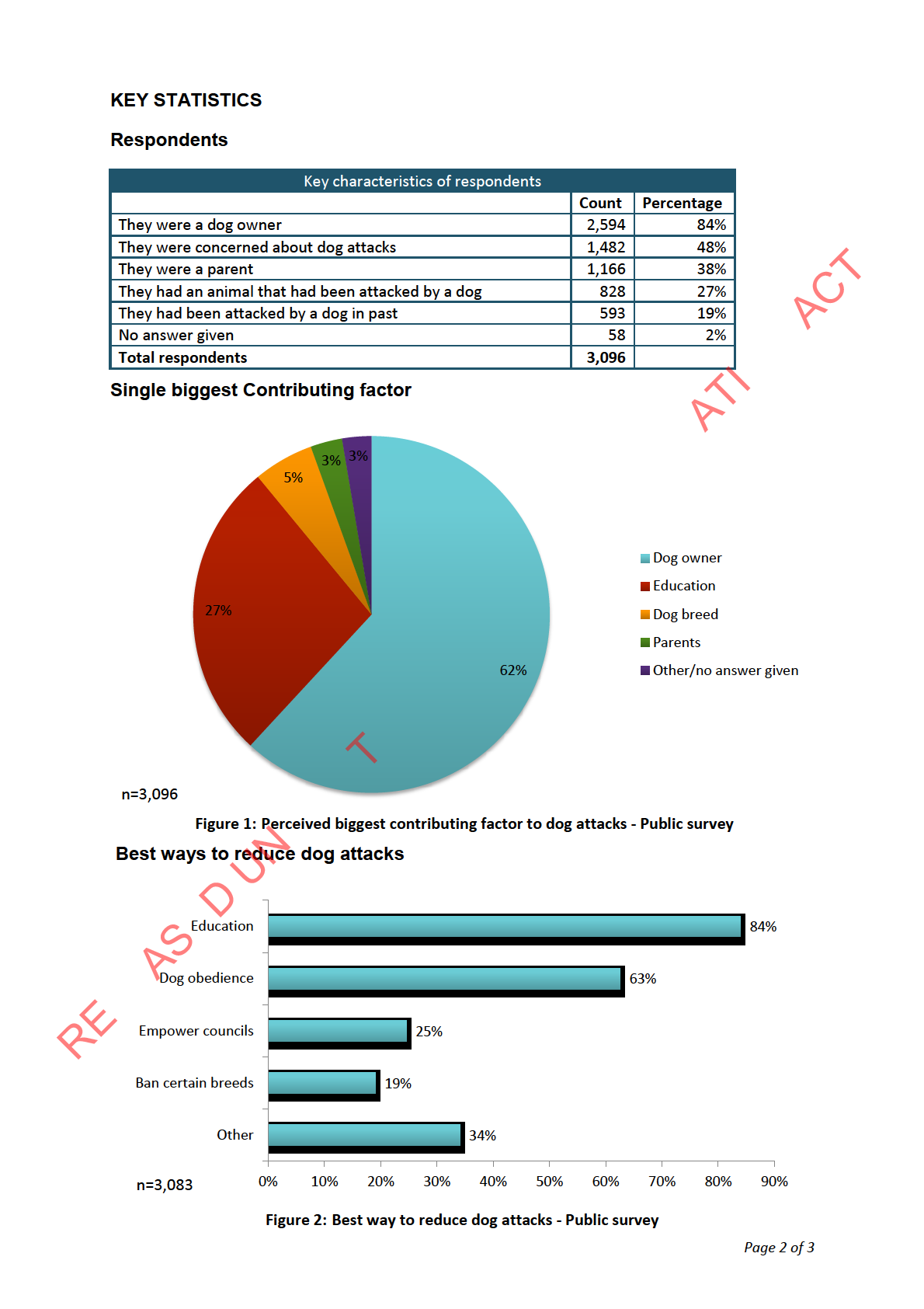
ACT
INFORMATION
RELEASED UNDER THE OFFICIAL
ENDS
ACT
N
NFOR
INFORMATION
FI
R
RELEASED U
RELEASED UNDER THE OFFICIAL
Page 3 of 3
ACT
N
NFOR
INFORMATION
FI
R
RELEASED U
RELEASED UNDER THE OFFICIAL
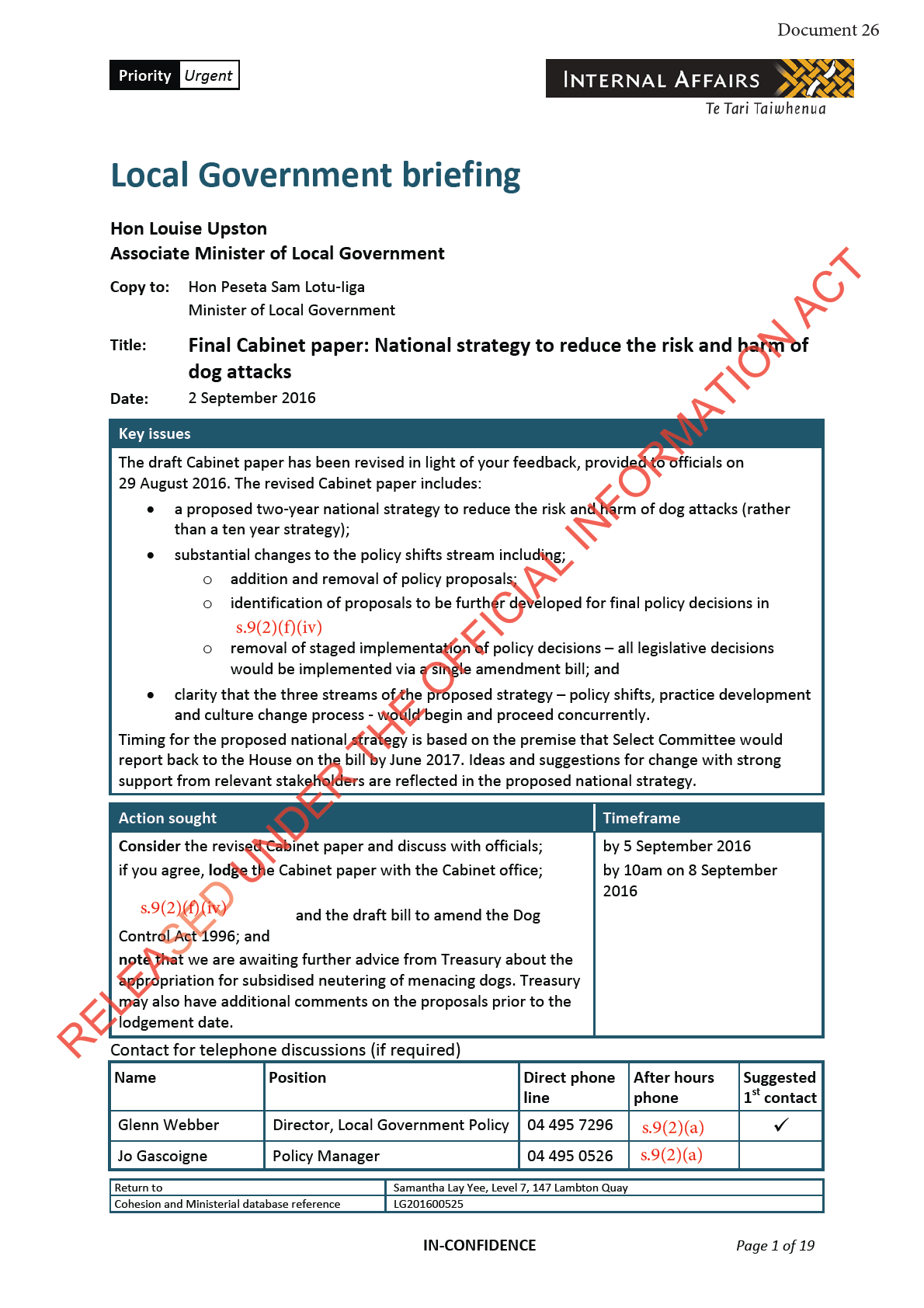
The Department of Internal Affairs
Te Tari Taiwhenua
Purpose
1.
This briefing outlines revisions to the draft Cabinet paper, provided to you on
26 August 2016, to incorporate your feedback. Due to the substantial changes made,
we have provided new versions of the paper, rather than a revision-tracked version.
2.
This briefing attaches the fol owing documents for your review and for lodging with
the Cabinet Office by 10am on Thursday 8 September for consideration by the Cabinet
Economic Growth and Infrastructure Committee, pending your approval:
•
the final Cabinet paper which attaches a revised national strategy (
Appendix A);
•
a final Cabinet paper with alternative financial recommendations to seek a year-on-ACT
year appropriation over a multi-year appropriation. We are currently seeking
advice from the Treasury on which appropriation to use (
Appendix B); and
•
the final Regulatory Impact Statement supporting the Department’s analysis and
proposed options (
Appendix C).
3.
It also attaches:
•
a list of current infringement offences and fines under Schedule 1 of the Dog
Control Act 1996 (the Act) (
Appendix D);
•
a work plan for implementation of proposed national strategy (
Appendix E); and
INFORMATION
INFORMATION
•
a summary of ideas and suggestions gathered throughout the stakeholder
engagement process (
Appendix F).
The revised national strategy will span two years, rather than ten years
4.
In light of your feedback, we have revised the proposed national strategy. We note
your emphasis on immediate action and long-term impact. By adjusting and removing
the Phase 2 and 3 proposals from the policy shift stream, we consider that the revised
national strategy can be implemented in a shorter timeframe via a single amendment
bill, without a phased approach.
5.
The previous version of the strategy took a phased approach, in recognition that
culture change, as a result of long-term public education, would be necessary for the
successful implementation of the proposals set out in Phase 2 and 3 (including
mandatory neutering of all dogs and breeder licencing). In light of your direction, these
measures have been removed.
We have amended the policy proposals to focus on the current population of high
risk dogs
6
Proposals in the policy shifts stream have been amended to change the focus from
reducing the future population of high risk dogs to reducing the current population.
We have refined policy proposals for immediate Cabinet consideration and implementation
RELEASED UNDER THE OFFICIAL
RELEASED UNDER THE OFFICIAL
7.
The revised Cabinet paper proposes the following package of legislative measures for
immediate implementation:
a) mandatory neutering of menacing dogs;
b) a requirement that classified dogs be securely fenced within private property;
c) a requirement for classified dogs to wear identification collars;
d) mandatory signage on properties containing classified dogs; and
IN-CONFIDENCE
Page 2 of 19
The Department of Internal Affairs
Te Tari Taiwhenua
e) a prohibition on the rehoming of classified dogs.
8.
Measures a, b and c were included in the previous draft Cabinet paper. Measures d
and e have been added at your instruction.
9.
If Cabinet agrees to the proposed package of proposals for immediate implementation,
we wil develop instructions for the Parliamentary Counsel Office (PCO) to begin
drafting a bil to amend the Dog Control Act 1996 (the Act).
10. The attached revised Cabinet paper also proposes three non-legislative measures
including:
• a fund to subsidise neutering costs for classified dogs (explained below);
ACT
• an educational campaign to drive a cultural shift towards responsible dog
ownership and general understanding of dog behaviour and safety around dogs.
This will be completed by the end of 2018; and
• a review and improvement of best practice guidance to enhance council delivery of
dog control services. This will be done in collaboration with the local government
sector to ensure councils have the knowledge and skil s they need to carry out their
dog control functions.
We are working with Treasury to refine the proposal for subsidised neutering of classified
INFORMATION
INFORMATION
dogs
11. The establishment of a fund to subsidise neutering costs for classified dogs was
proposed in the previous draft Cabinet paper, and more detail is provided in the
CIAL
revised paper. The purpose of the subsidy is to incentivise owners of classified dogs to
have them neutered. The proposed subsidy wil assist owners of menacing dogs meet
the proposed neutering requirement before it comes into effect. We anticipate that,
OFFICIAL
once the package of immediate proposals is implemented, the level of non-compliance
with measures requiring the neutering of menacing dogs will be lower as a result of
the subsidy.
12.
s.9(2)(f)(iv)
13
We are awaiting the Treasury’s advice and feedback on the most recent version of the
draft Cabinet paper and Regulatory Impact Statement that includes costs for
subsidised neutering of menacing dogs, which were finalised on 1 September 2016.
We have requested advice about whether to seek a multi-year appropriation for the
RELEA
RELEASED UNDER THE
neutering subsidy fund. The Treasury may seek to make additional comments on the
Cabinet paper and proposals prior to lodging on Thursday 8 September 2016.
IN-CONFIDENCE
Page 3 of 19
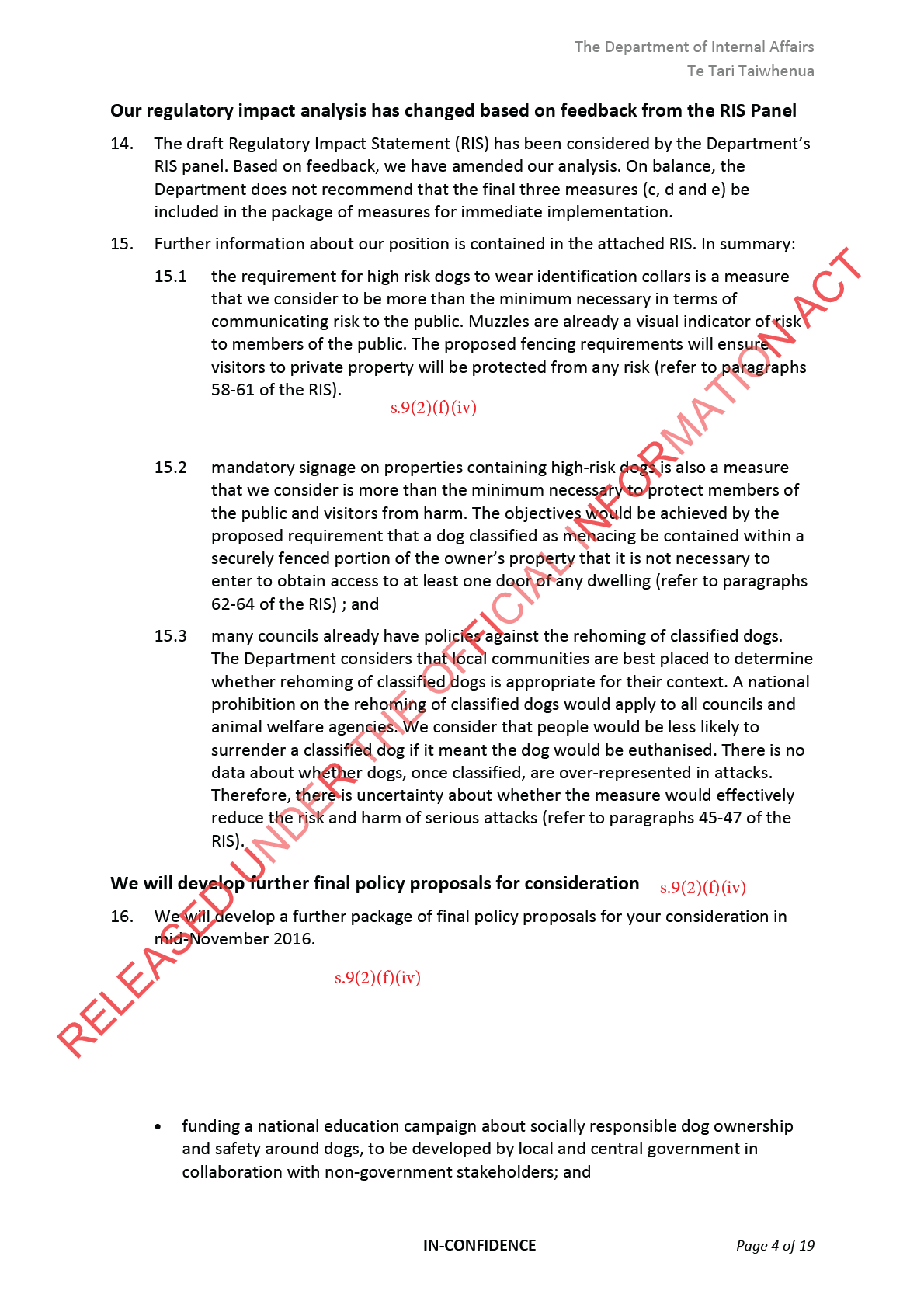
The Department of Internal Affairs
Te Tari Taiwhenua
•
working with the local government sector to review and improve best practice
guidance, in order to enhance council delivery of dog control services.
17. We intend to also consider technical measures that would clarify the Dog Control Act
1996 (the Act) for dog control officers.
18. At this stage, the revised attached Cabinet paper seeks in principle agreement to
proceed with the development of the package of final policy proposals.
19. There is a one-week Parliamentary recess between 21 and 25 November 2016.
s.9(2)(f)(iv)
ACT
N
20.
We have removed some proposals that would require long-term culture change
21. As instructed, proposals around breeder licencing and mandatory neutering of all dogs
have been removed. Such measures could be considered at a later date, once we have
NFOR
INFORMATION
established a culture of socially responsible dog ownership and safety around dogs in
New Zealand.
The three streams of the national strategy wil run concurrently
22.
The proposed national strategy consists of thre
FIe streams - policy shifts, practice
development and culture change process. The revised Cabinet paper makes it clearer
that al of the streams would begin immediately after Cabi
OFFICIAL net decisions and continue
to run concurrently.
23. The revised policy shift stream involves implementation of all proposed legislative
measures via a single amendment bill. The bill will give effect to policy decisions
confirmed by Cabinet on 19
R September 2016 s.9(2)(f)(iv)
24. The revised best practice stream, to be led by Local Government New Zealand,
involves a review and improvement of best practice guidance for councils about:
•
increasing uptake of registration, microchipping and neutering;
•
promoting responsible dog ownership;
•
information sharing; and
•
enforcement – including breed identification and amendments to the Act once
made.
25. The revised culture change process stream will be led by central and local government,
RELEASED U
RELEASED UNDER THE
with input from stakeholders including the Accident Compensation Corporation, the
New Zealand Institute of Animal Managers, dog behaviour specialists, the Royal New
Zealand Society for the Prevention of Cruelty to Animals and others with relevant
expertise.
26. The culture change process wil involve the development and of a national educational
campaign about social y responsible dog ownership and safety around dogs. The
IN-CONFIDENCE
Page 5 of 19
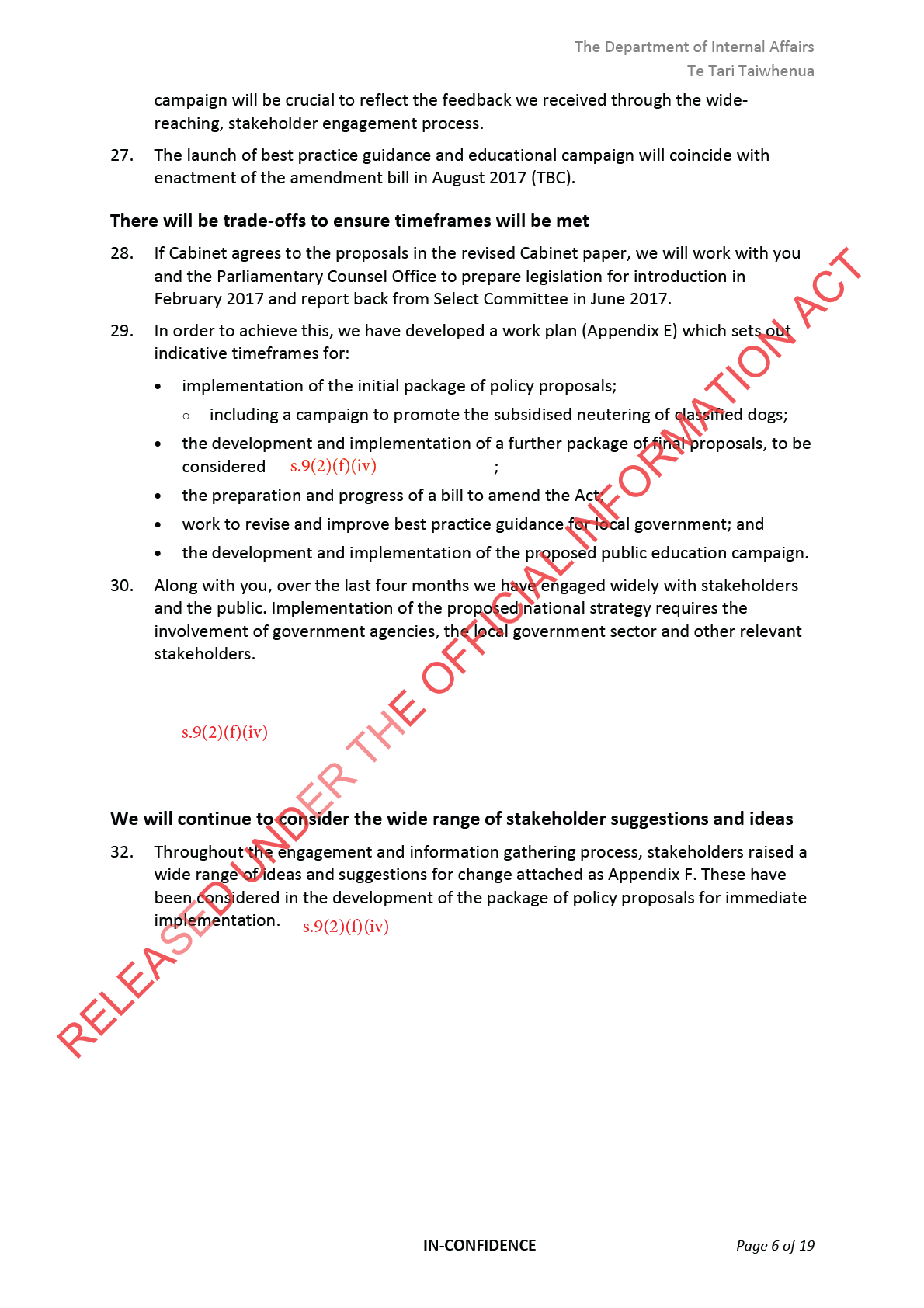
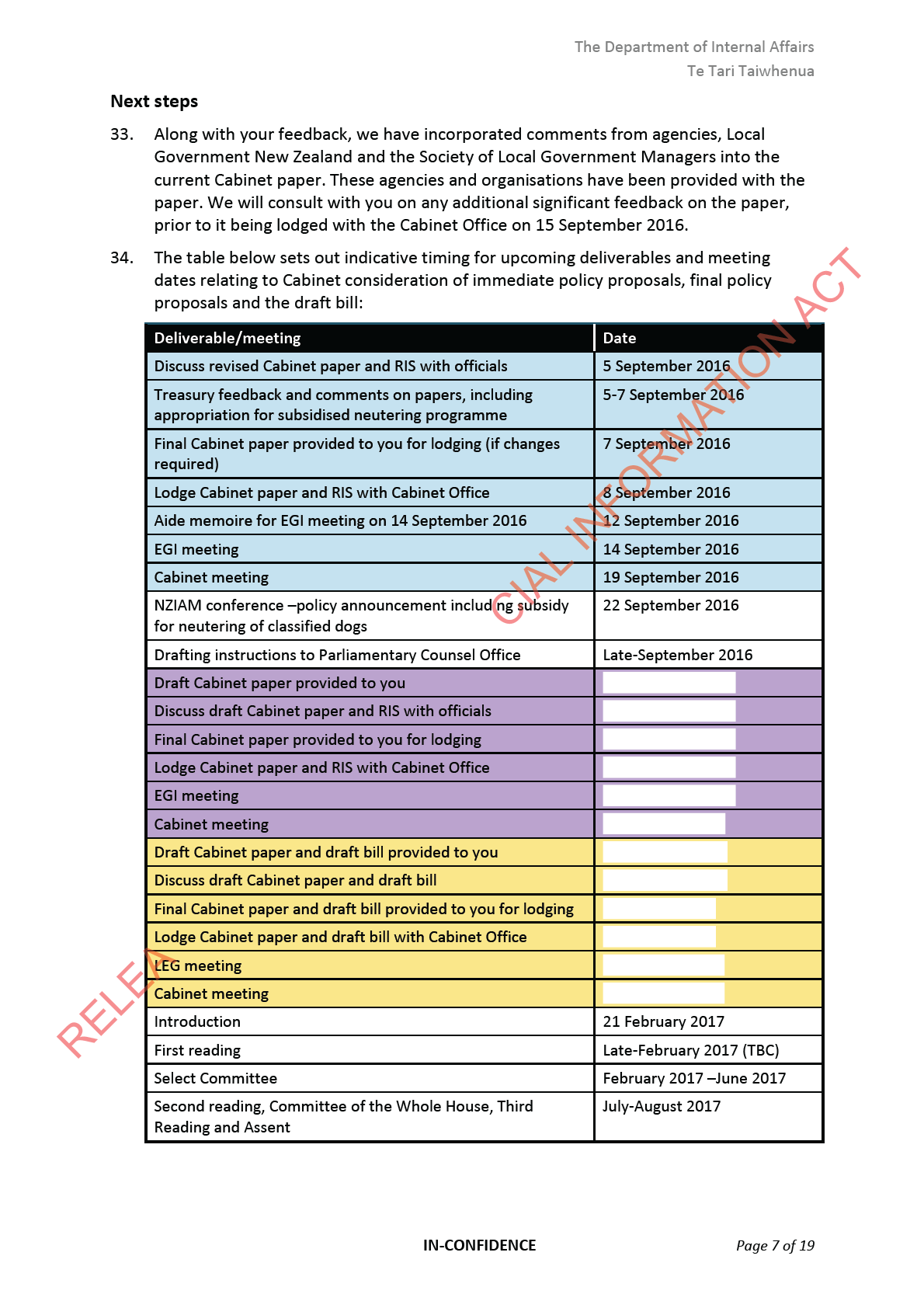
ACT
INFORMATION
OFFICIAL
s.9(2)(f)(iv)
RELEASED UNDER THE
The Department of Internal Affairs
Te Tari Taiwhenua
Recommendations
35. We recommend that you:
a)
consider the revised Cabinet paper and
discuss with officials;
Yes/No
b)
s.9(2)(f)(iv)
c)
note that we are awaiting further advice from Treasury about
ACT
appropriation for subsidised neutering of menacing dogs.
N
Treasury may also seek to make other comments on the package
of papers; and
d)
if you agree,
lodge the Cabinet paper with the Cabinet office by
10am on 8 September 2016.
Yes/No
NFOR
INFORMATION
Glenn Webber
Director, Local Government Policy
FI
OFFICIAL
Hon Louise Upston
Associate Minister of Local Government
R
/
/
RELEASED U
RELEASED UNDER THE
IN-CONFIDENCE
Page 8 of 19
The Department of Internal Affairs
Te Tari Taiwhenua
Appendix A: Penultimate draft Cabinet paper
ACT
N
NFOR
INFORMATION
FI
OFFICIAL
R
RELEASED U
RELEASED UNDER THE
IN-CONFIDENCE
Page 9 of 19
































